Sander Berge is a 21-year-old defensive midfielder from Norway currently plying his trade in the Belgian Pro League for Genk. At just 21 Berge has a host of first-team football under his belt having played 125 senior games for Genk and Vålerenga. Genk won the Belgian Pro League by seven points last season and Berge played 1,373 minutes from a possible 2,700. To add to this, Berge played 390 minutes for Genk in the Europa League. He made his Norway debut in 2017 and as 14 caps to his name today. With various outlets reporting in the last six months that Berge is wanted by the likes of Roma, Tottenham, Manchester City and Benfica – the question is; is he ready for the step up? In this tactical analysis, we will look at the two sides to Berge’s game using statistics: his defensive capability and his offensive ability.
Berge’s defensive capability
It goes without saying that as a defensive midfielder it would be desirable if you can defend. As such, I will cast my eye over Berge’s performance and profile in this aspect of the game.
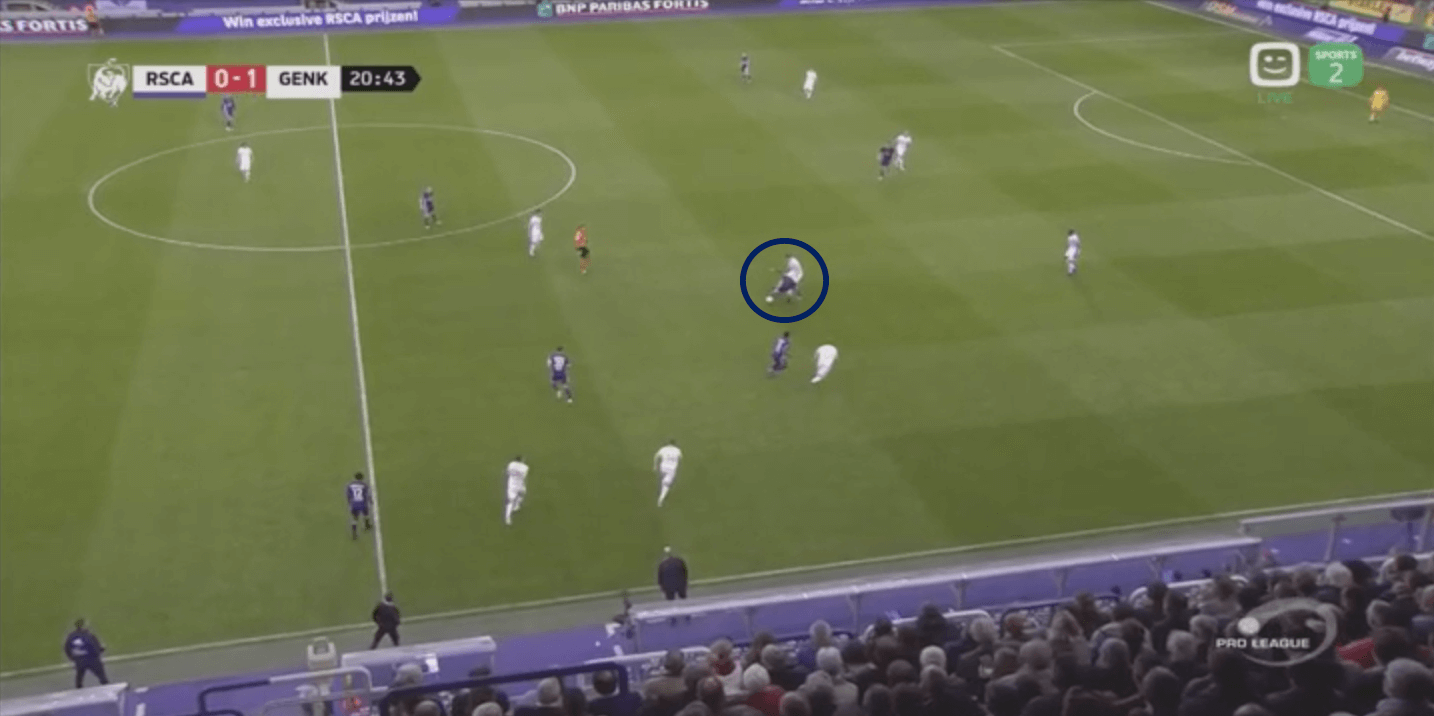
Berge is an aggressive defender and often finds himself pressing and harrying opposition players from behind trying to force a turnover. In the example above and below, Berge presses a ball-carrier as soon as he receives the ball, taking care not to foul him. He uses his physical strength to win the ball and then once in possession he calmly dribbles aware from the danger, securing possession for his team.
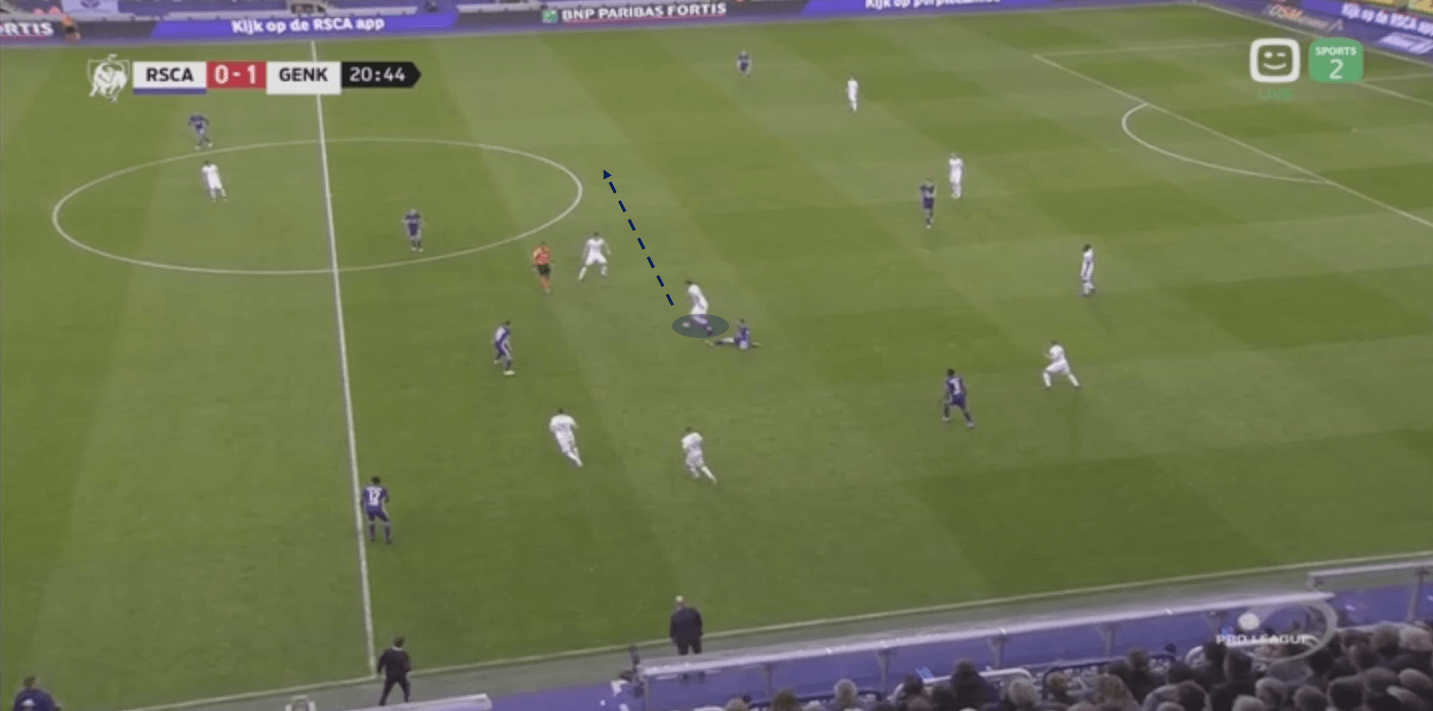
However, he is also capable of turning over the opposition when running back towards his own goal. In the example below, the Antwerp playing is attempting to start a counter-attack. Berge comes across, easily pushes him off the ball and lays the ball back to his defenders.
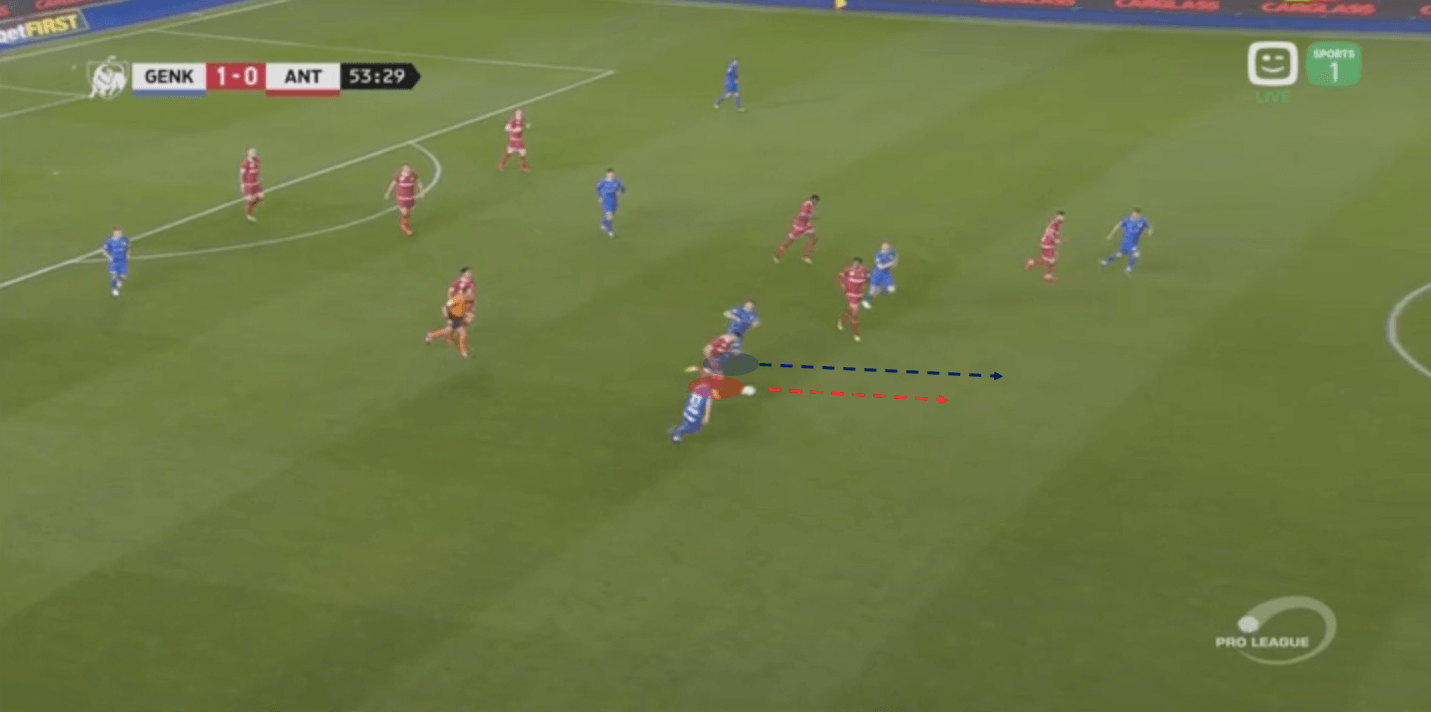
Sensing of danger
Another impressive aspect to Berge’s game at such a young age is his sense for when danger is developing and his ability to snuff it out or avert it. Genk’s back four often defend in a very aggressive manner which often leads to their defensive line becoming somewhat disjointed should they not win the ball at the first attempt.
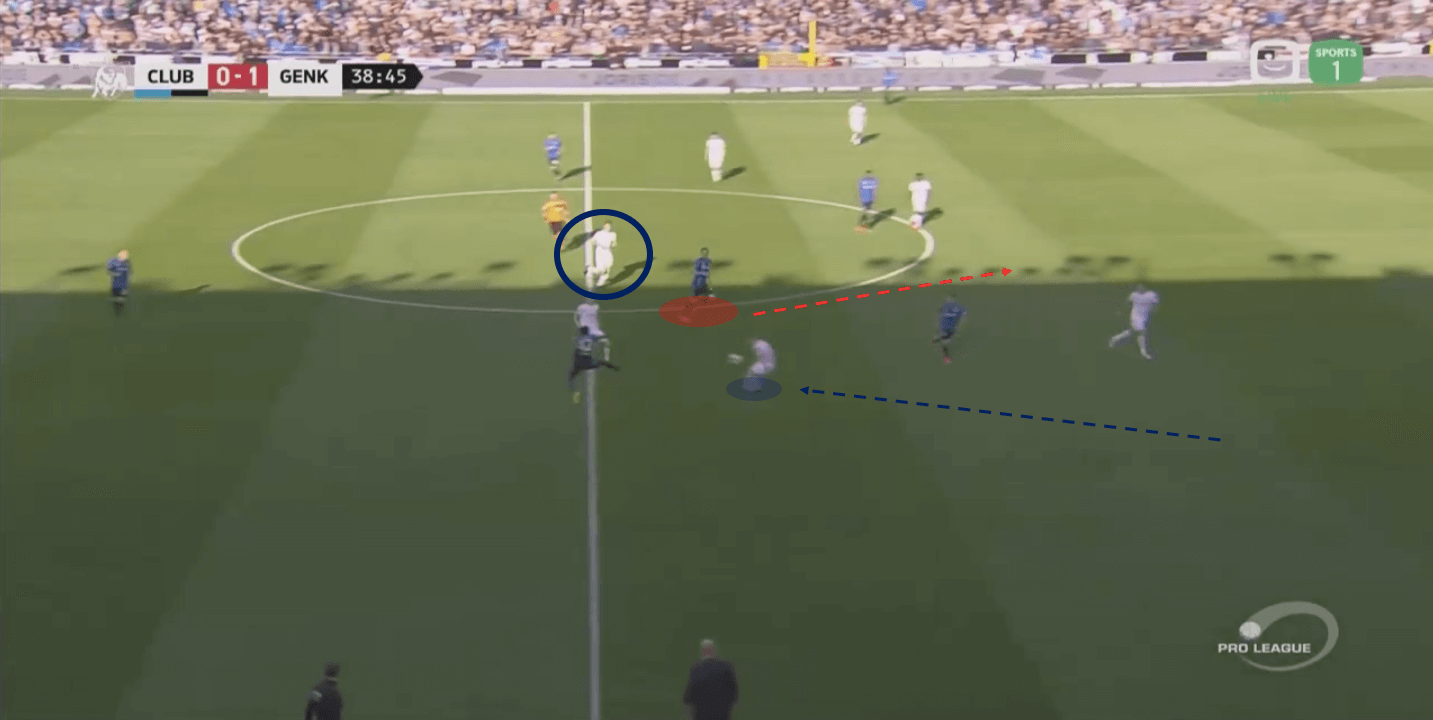
In the image above, Genk’s left-back attempts to win the ball back on the halfway line and pushes up and out from the back four, disjointing the defensive line. Berge is circled in the centre circle with a Club Brugge player nearby and in his eye line.
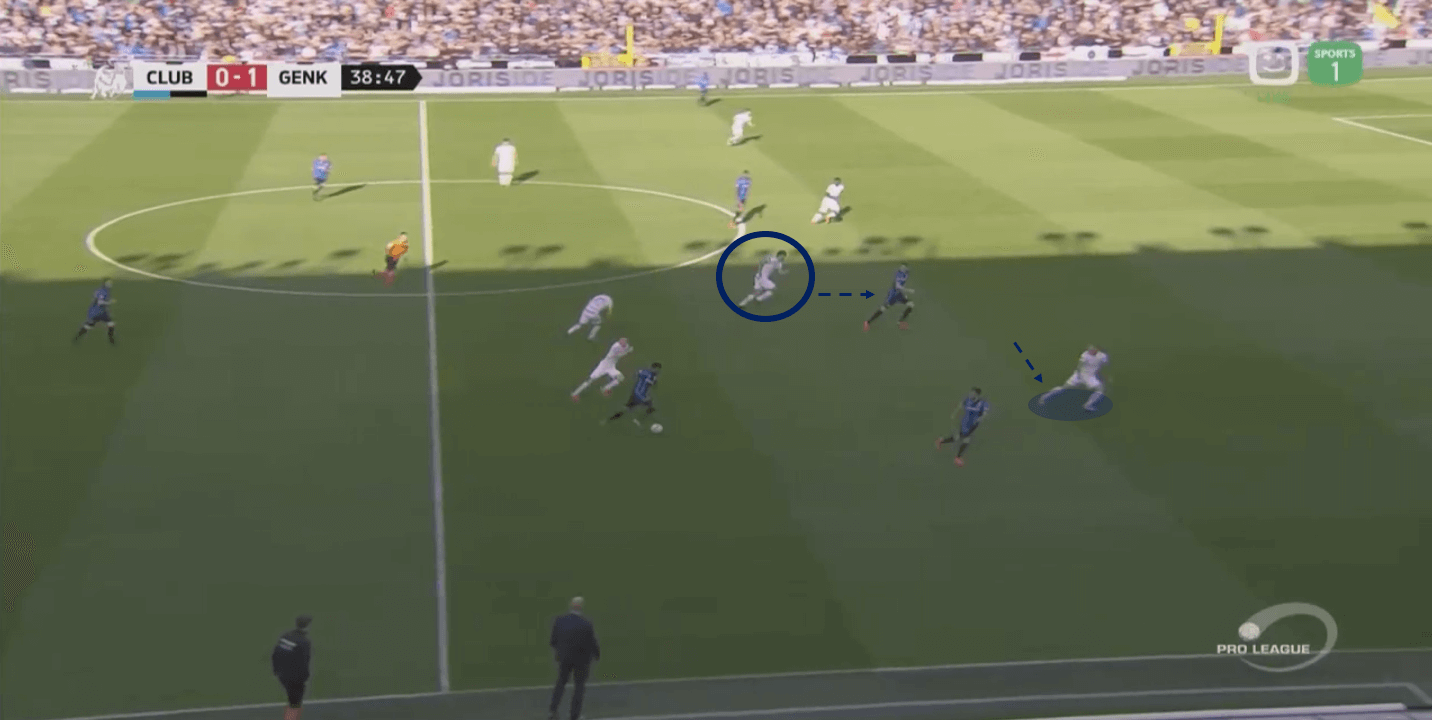
The movement of the Club Brugge attackers forces Genk’s left-sided centre back to cover his left-back in the wide channel. This opens a huge hole between Genk’s two centre-backs. Berge sees this and sprints back to fill the hole and prevent the Club Brugge midfielder from breaking through on goal.
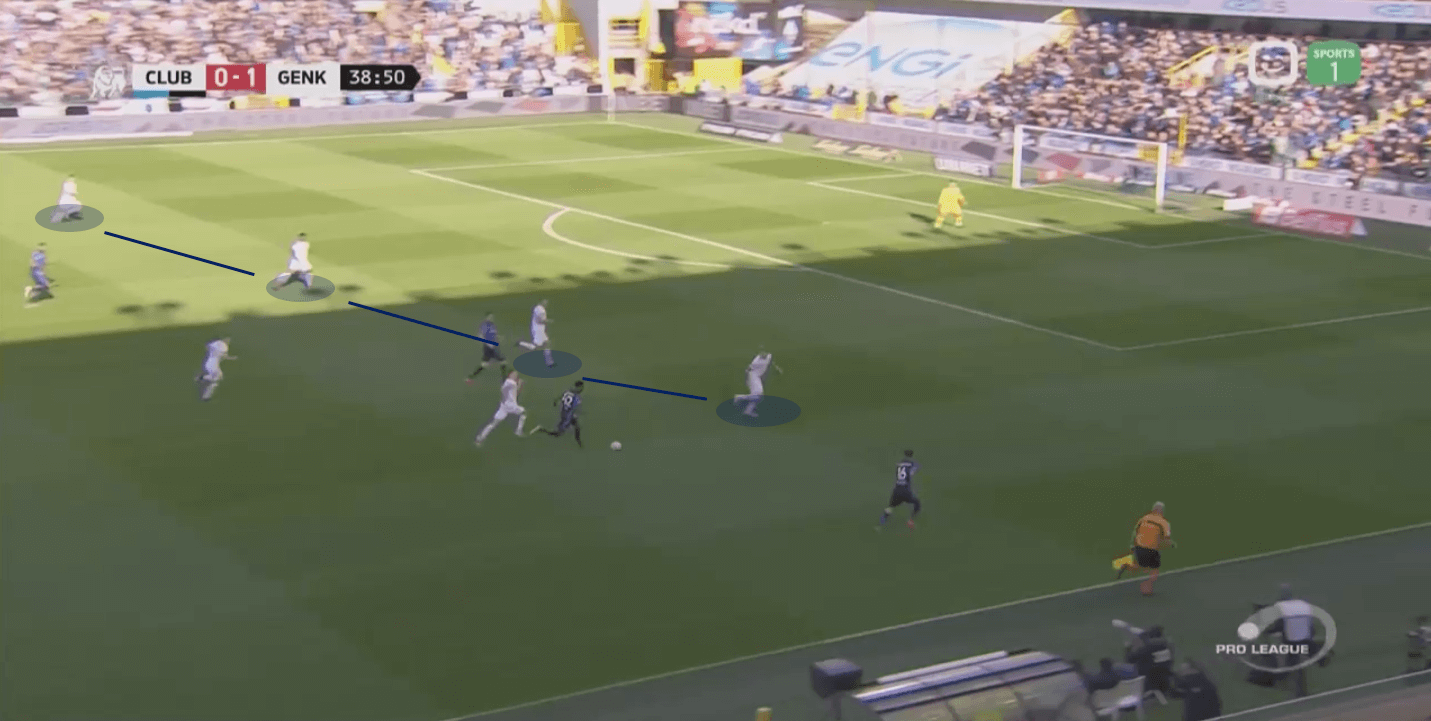
Berge’s early sensing of the danger allows him to get back and cover in the left-centre back position and the direct threat on the Genk goal is prevented.
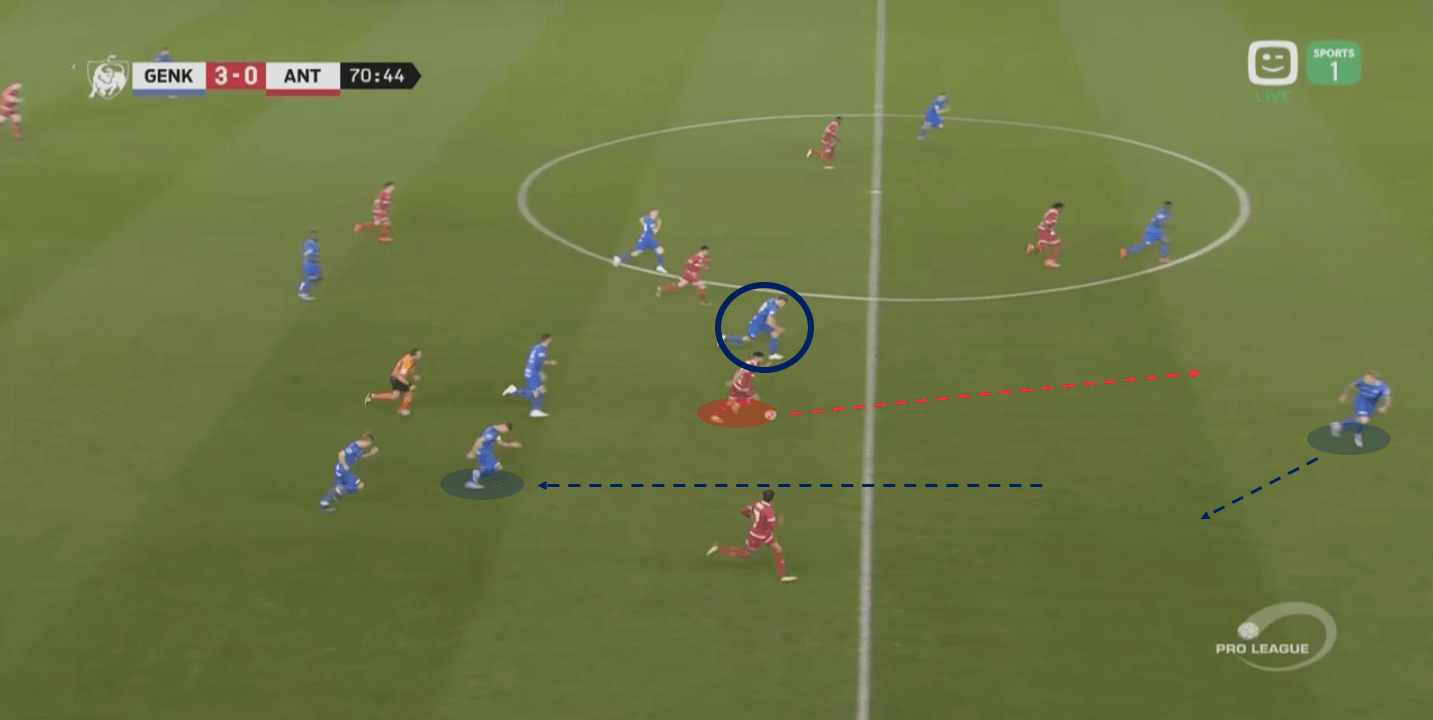
In a very similar situation from another game in the Belgian Pro League, Berge is again sprinting back in order to cover the aggressive pressing of Genk’s left-back. The Genk left-sided centre-back is again forced to cover in the left channel which leaves a large gap in the Genk defensive line.
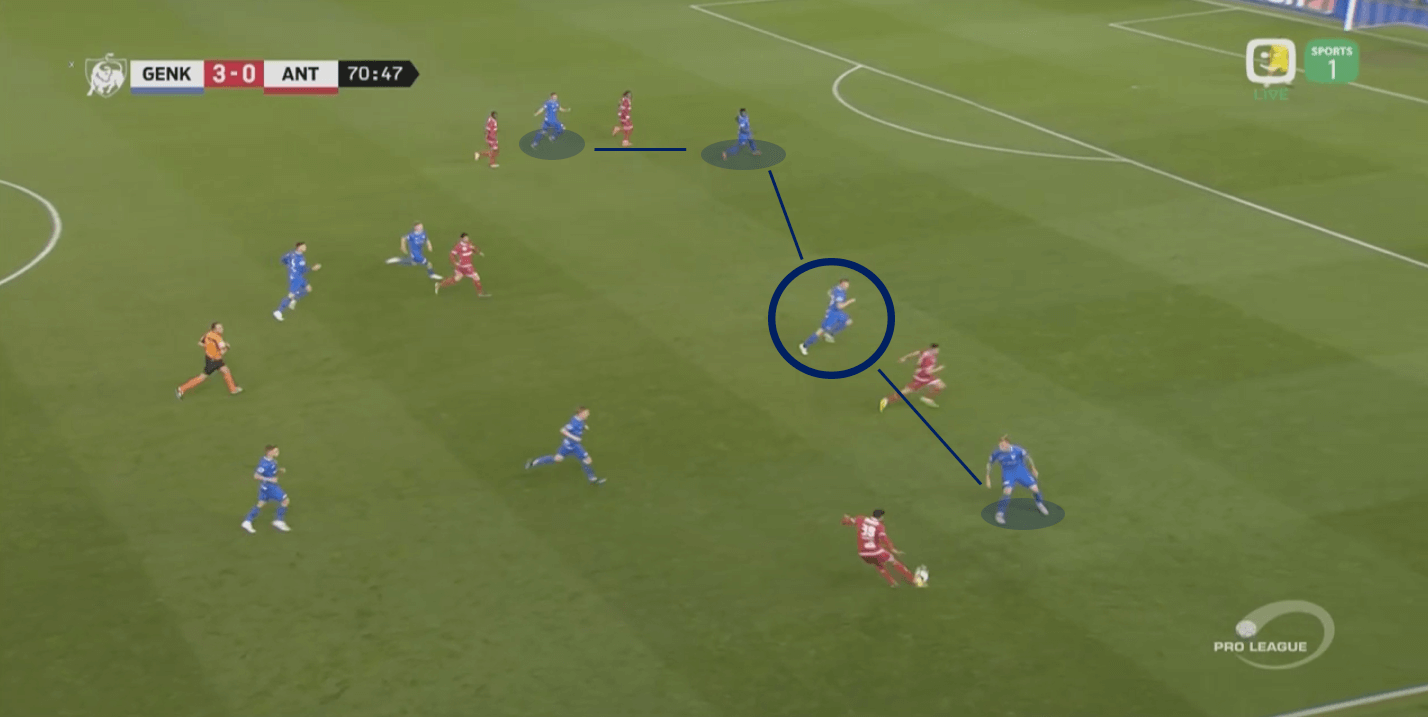
Again, Berge’s early sensing of the danger prevents a direct threat on the Genk goal as he tracks back and covers the space left by the left-sided centre-back.
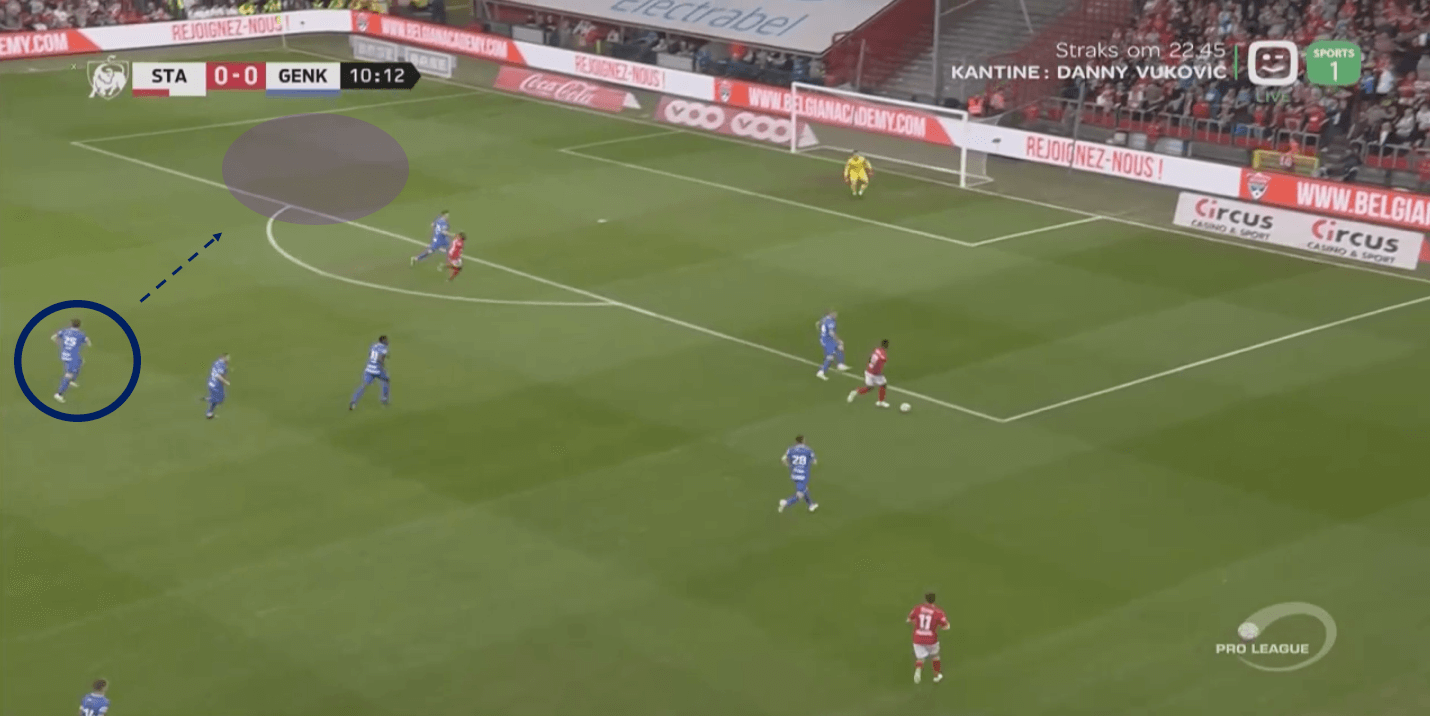
We can see in the two previous examples that Berge is competent at covering on the left-side of Genk’s defence. This could be due to Berge becoming used to his side’s left-flank defending more aggressively and often leaving spaces that he must fill. We can see in the image above, however, that he is also competent at covering space on the other side of the pitch. Standard Liège’s is more advanced and developed than the attacks in the two previous examples. All of the Genk defenders’ eyes are on the ball, except for Berge’s. He has noticed the space opening at the back post area of the box. Out of the picture is the Standard left-winger making a break for the box. Berge can see the danger developing.
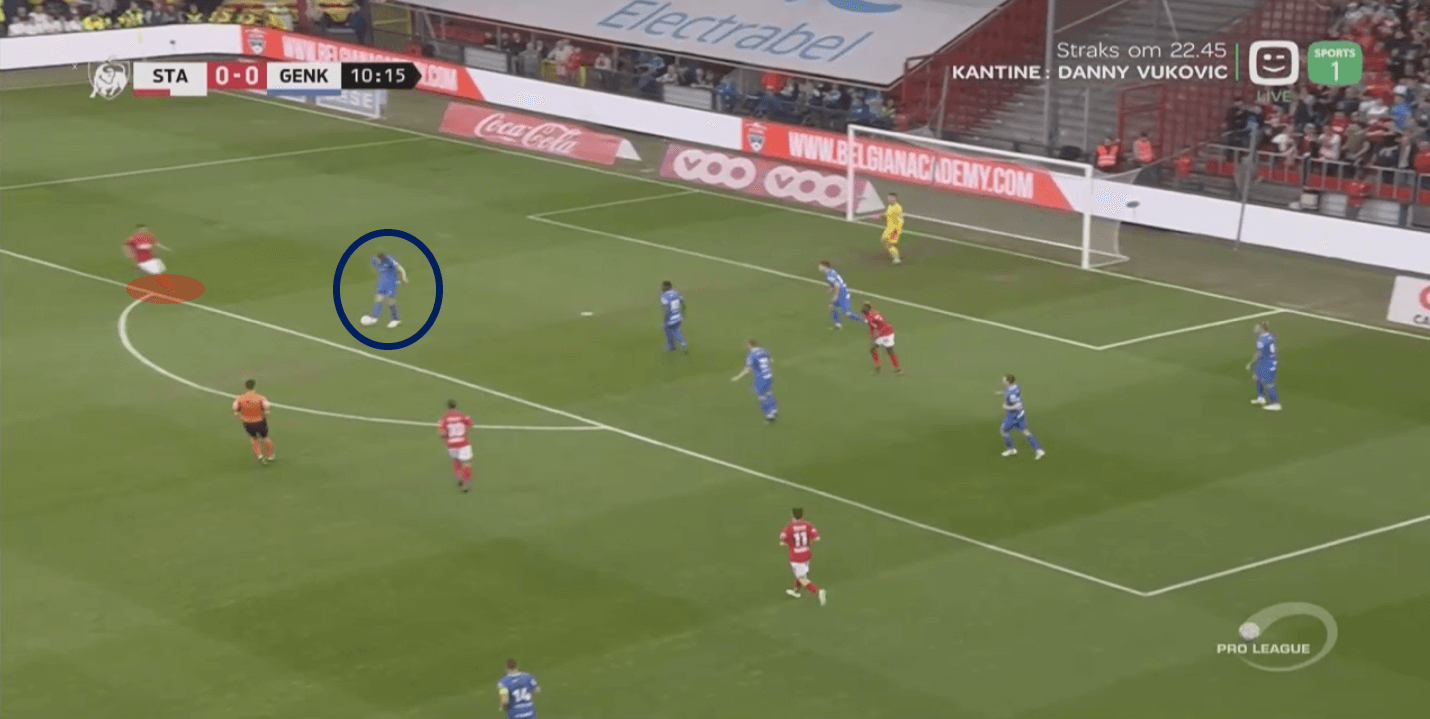
As in the previous examples noted, due to Berge’s early sensing of a threat on his goal developing he is able to get himself back into the optimal position to clear the ball away. Had Berge not noticed this threat, the Standard winger would have been unmarked with the ball 10 yards from goal.
Positioning and composure
Sander Berge combines solid positioning and composure ahead of his age to perform effectively as a defensive midfielder in an attacking side. This season Berge made 4.56 interceptions per 90. Below we will look at a number of examples.
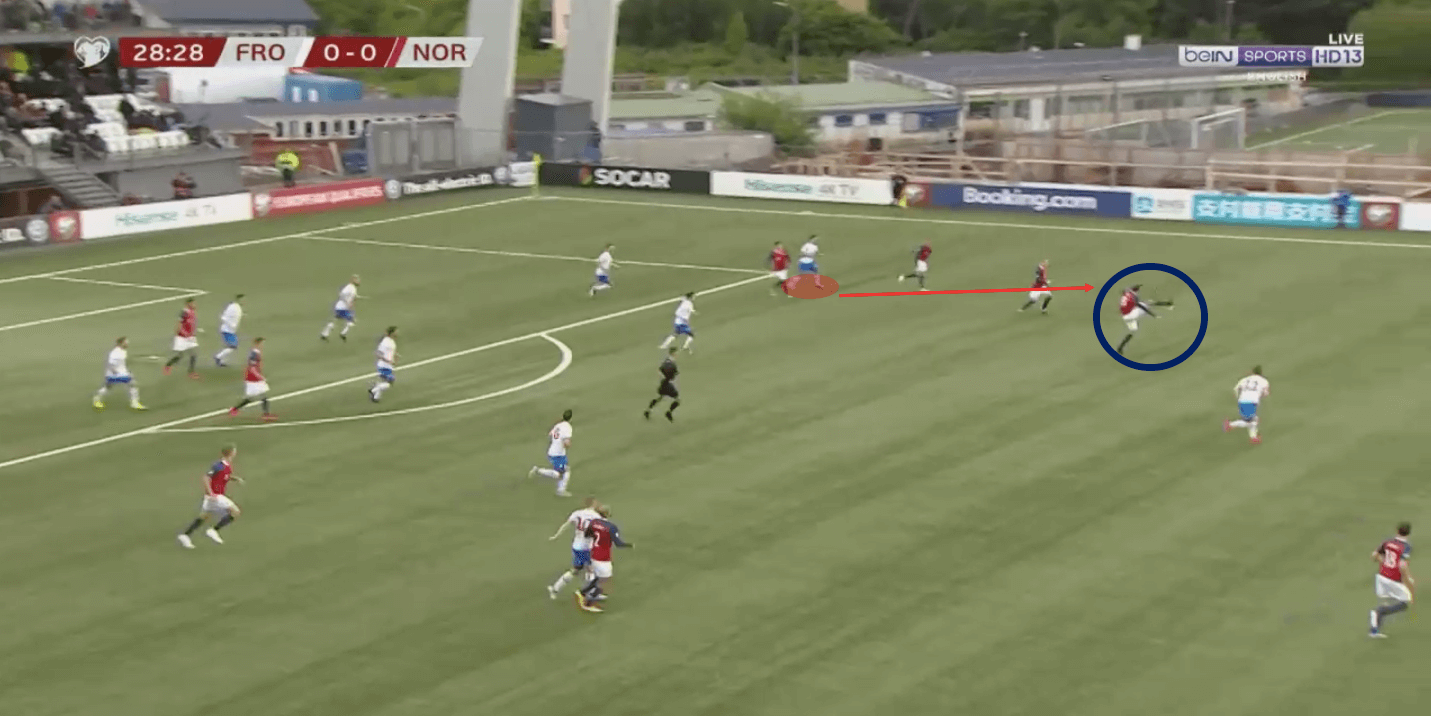
In a EURO 2020 qualification game shown above, Norway (as would be expected) are on the front foot against the Faroe Islands. The Faroes are attempting to clear the ball from their box and initiate a counter-attack. Norway have seven players committed to the attack and the ball is being cleared into the path of the Faroe Islands’ striker. Berge is able to stick out his left-foot and bring the ball under his control. He loses his balances and falls over but he doesn’t panic and calmly nudges the ball to his nearby teammate from the ground.
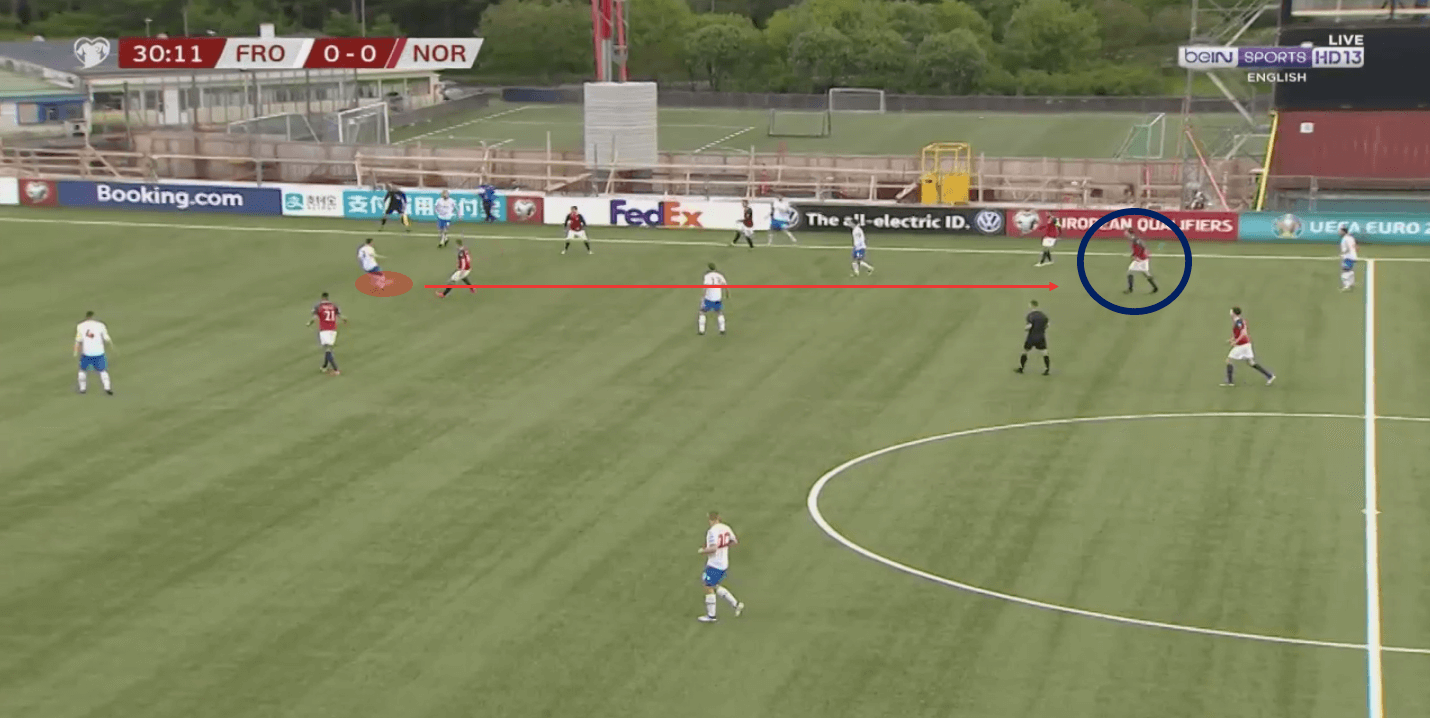
From the same game, the Faroe Islands are trying to play out from the back. The Faroe Islands’ defender looks to play a defence-splitting pass up to the centre-forward. Berge reads the pass and steps across the intercept. He brings the ball under control and lays the ball off to his midfield partner who proceeds to spread the ball out wide.
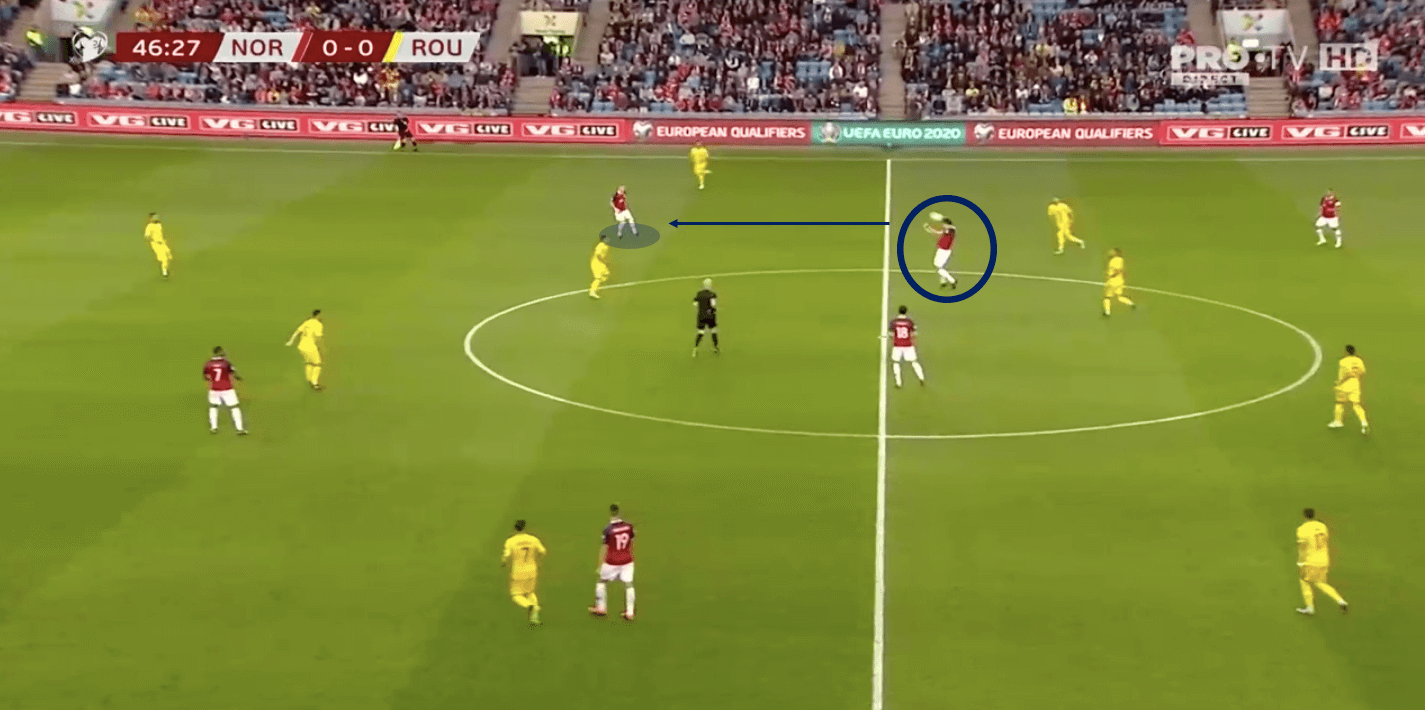
Another strong aspect of Berge’s play that combines positioning and composure is his calmness when dealing with aerial balls in midfield. With his 6ft3, 88kg frame Berge is an imposing physical presence. He wins 50.5% of his aerial duels per 90 however, what is most impressive with regards to his aerial ability is his composure when dealing with the ball in the air. In the image above, a Romanian goal kick is dropping to Berge in the centre-circle. A lot of players would be quite blinkered in this situation and would take the risk-free option of heading the ball straight back where it came from.
This would surrender possession but would ensure that Berge didn’t give up the ball in a dangerous position in the centre of midfield. Berge, in fact, has a clear sense of the players and the situation around him. Instead of heading the ball straight back down the pitch he calmly nods the ball down to the teammate to his right, starting an attack for his team.
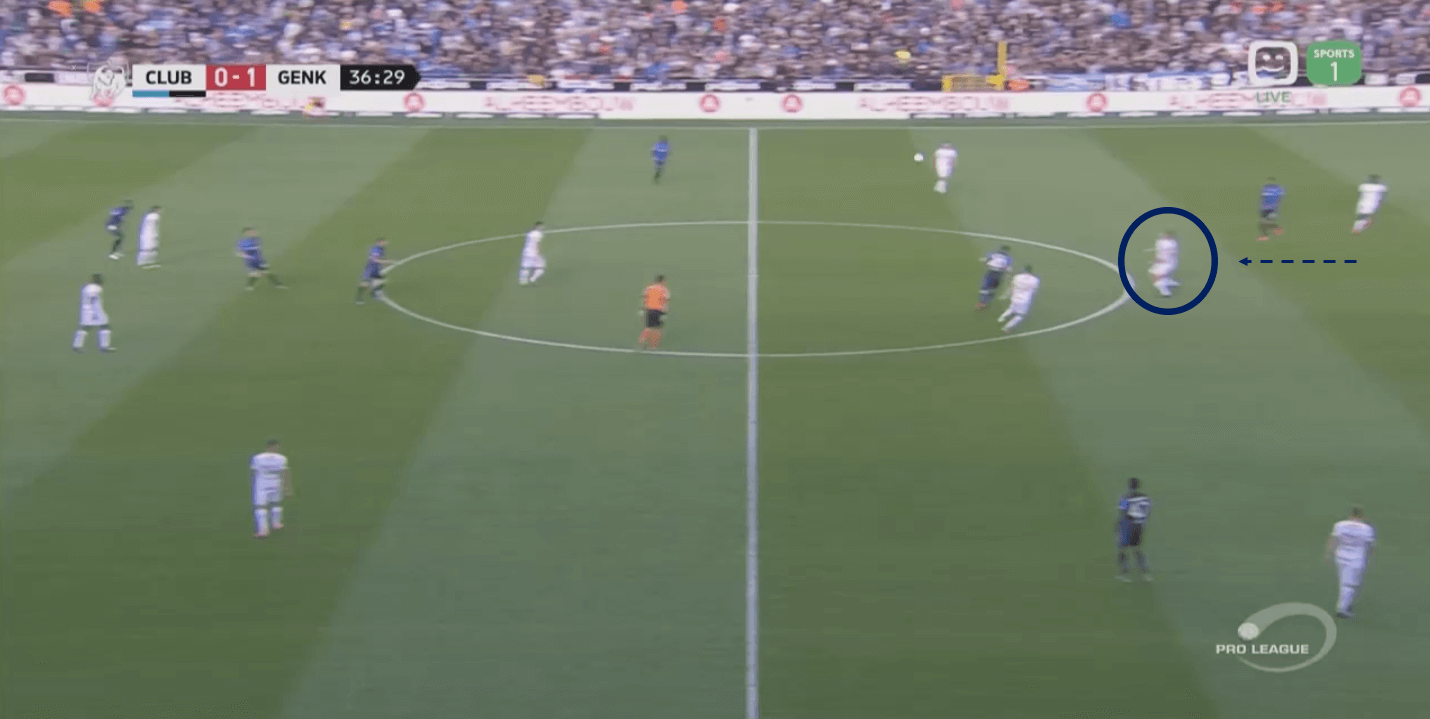
In a similar situation from a club game against Club Brugge, Berge is attacking the ball from a deeper position. As he is attacking the ball at pace, one would expect him to head the ball forward with power, looking to get as much distance on the header as possible.
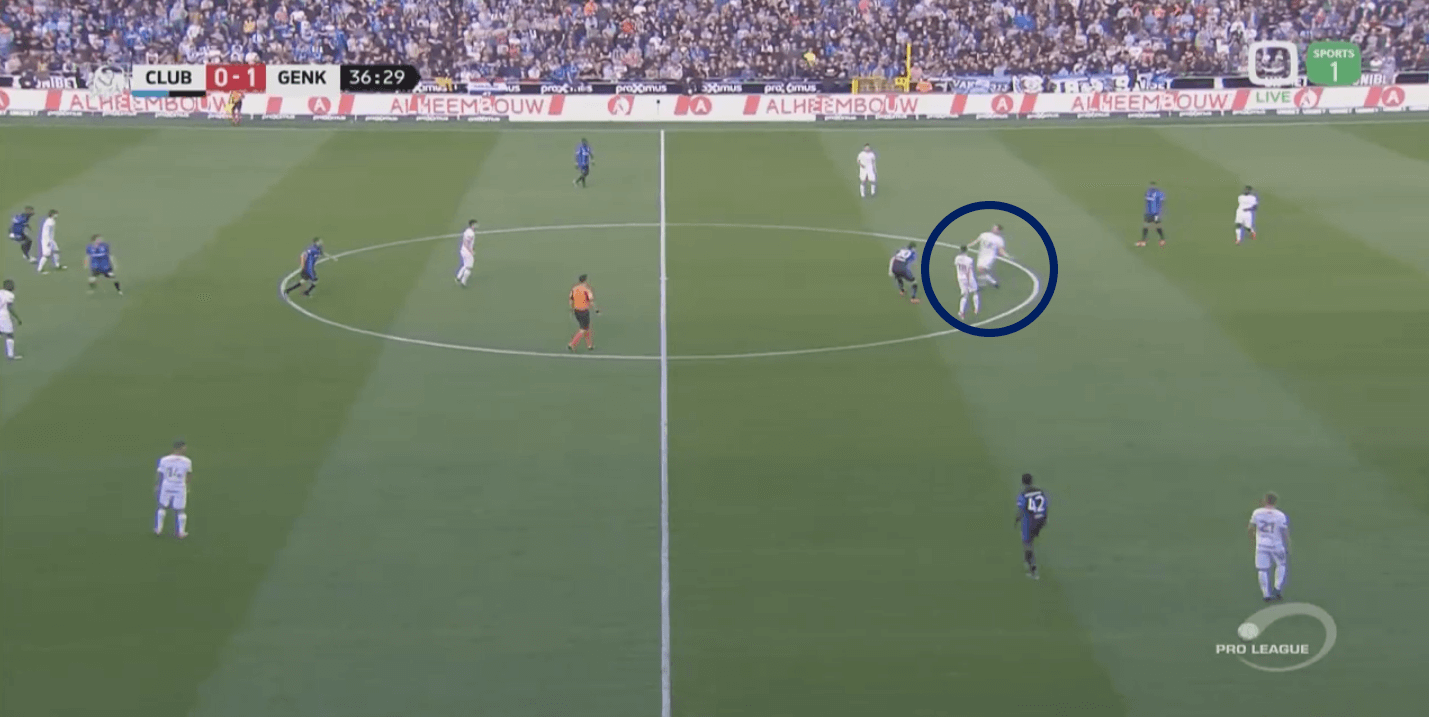
However, as Berge did for Norway he is aware of the situation around him. Genk have a mini 2v1 in the centre of the pitch. Berge lifts his head and cushions the ball with his chest to his nearby teammate, securing the ball for his side.
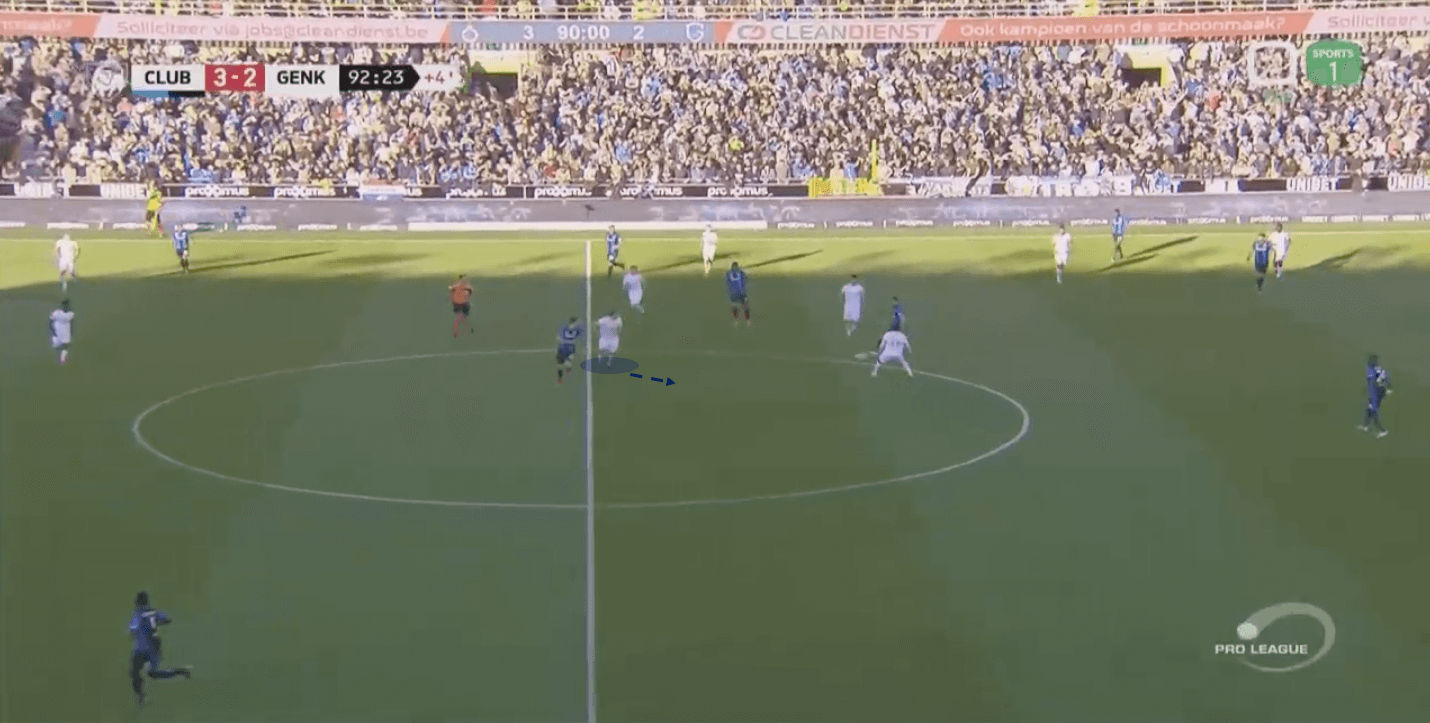
Berge does have the ability to start his own attacks from time to time rather than simply laying the ball to a teammate. In the image above, Genk are pushing for a late equaliser against Club Brugge. Brugge are attempting to play through midfield. Berge reads the attempted pass and steps in to win the ball back.
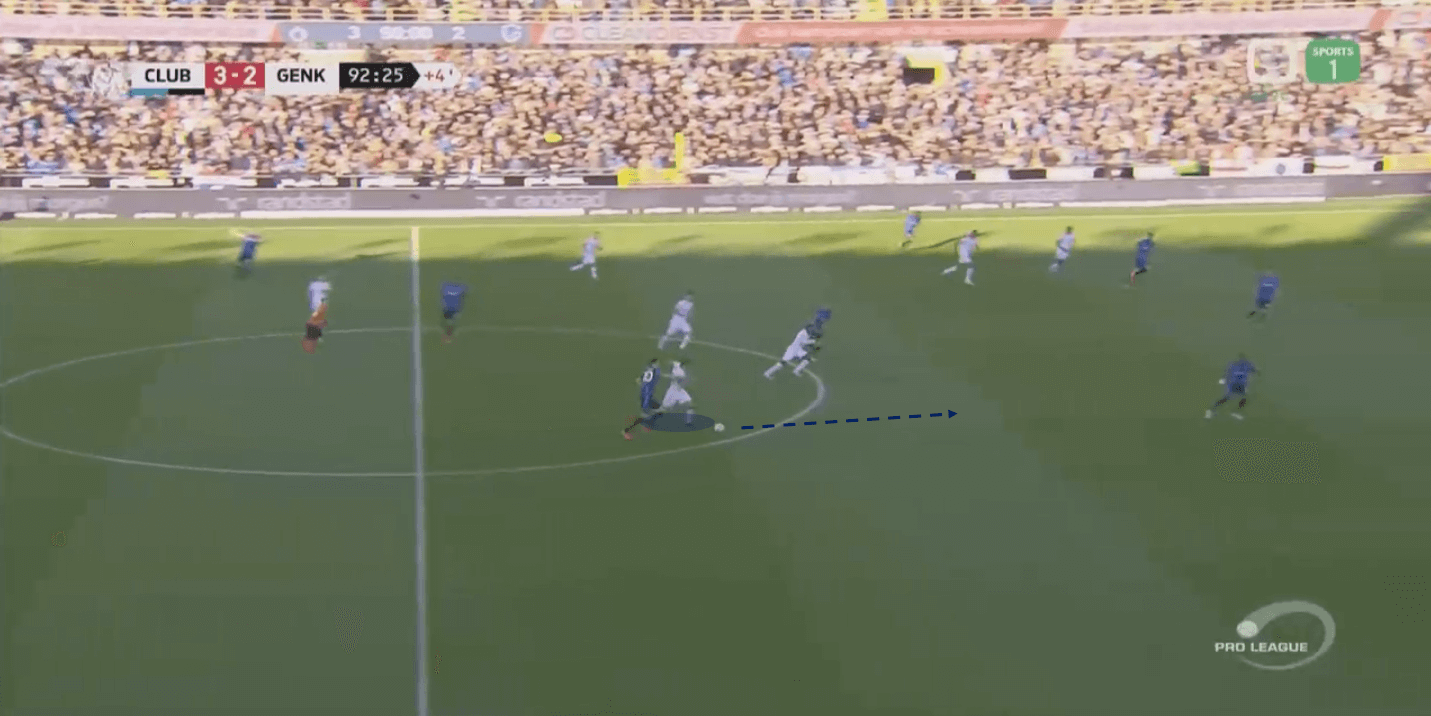
On this occasion, once Berge has secured the ball he holds off the opposition midfielder and breaks towards the Brugge defence.
Lack of agility and balance
So far, this player analysis has given Berge a glowing report. However, there are some fairly glaring issues with his defensive play at times. Berge is a big guy and sometimes his size and decision making work against him. Berge can be particularly vulnerable when he is tasked with defending large areas or in 1v1 situations against tricky, more agile opposition players. His vulnerability is highlighted in his defensive duels numbers. Last season he had a success rate of 19.1% in his defensive duels. This ranks Berge 50th amongst other central midfielders in the Belgian Pro League with a minimum of 900 minutes.

In the image above, Berge is the lone defender in the Genk midfield. He is tracking back when the Club Brugge midfielder cuts back inside. Berge can’t change his momentum back inside to dispossess his man causing him to over chase.
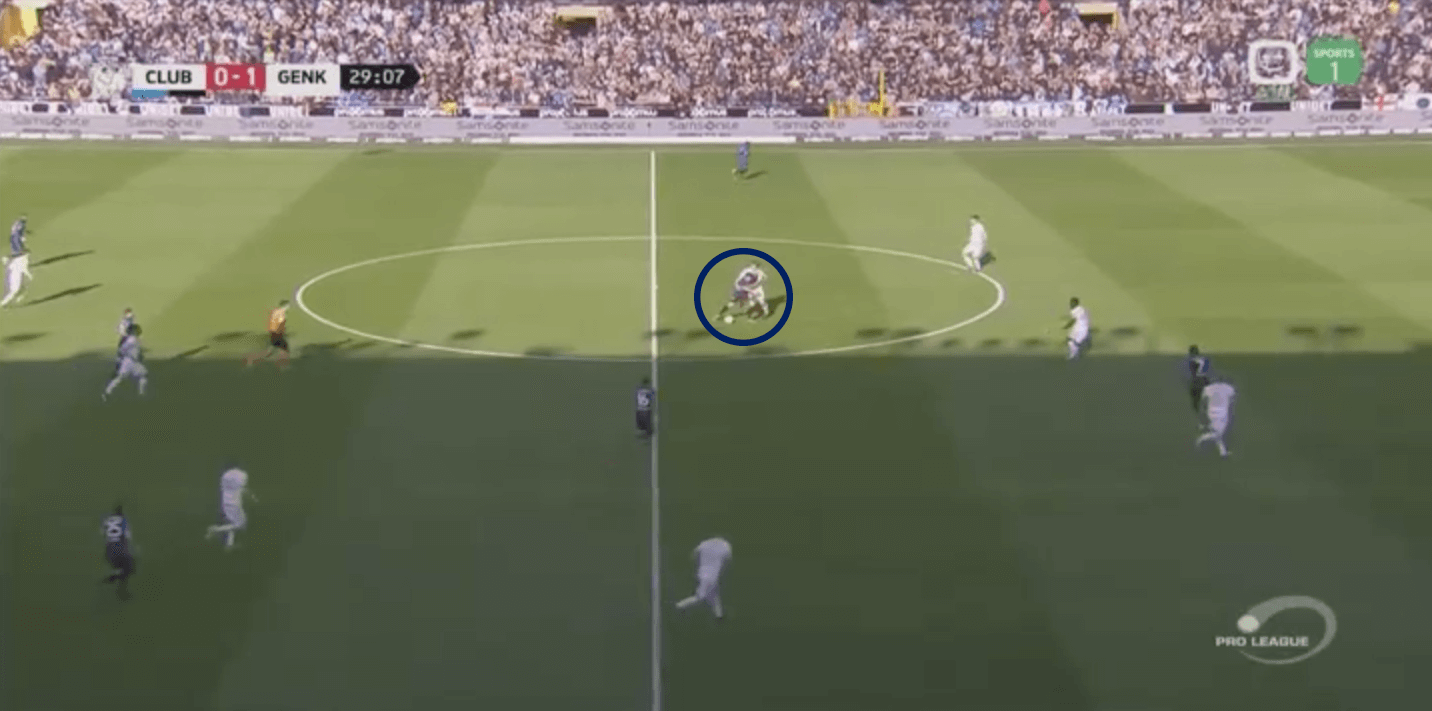
Having over chased and unbalanced himself, Berge feels the only option is to grab a hold of the Brugge player with both arms giving away a free-kick and picking up a booking. Some may highlight this as a good example of tactical fouling, but even if that is the case it is not ideal for your defensive midfielder to be on a booking 30 minutes into a huge game against a title rival due to his lack of agility and balance.
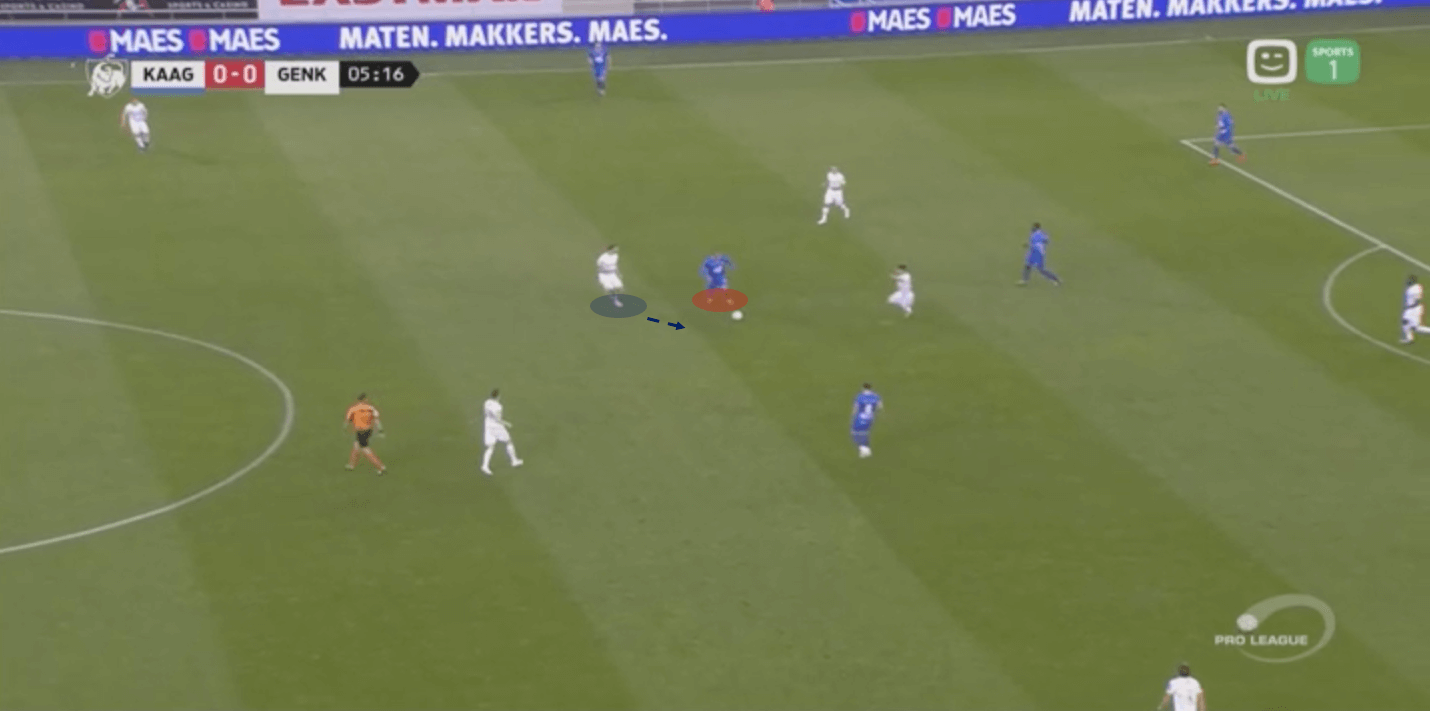
In the image above, Berge is aggressively pressing a man from behind which he often does. He ends up forcing the Gent player back to within 30 yards from his own goal.
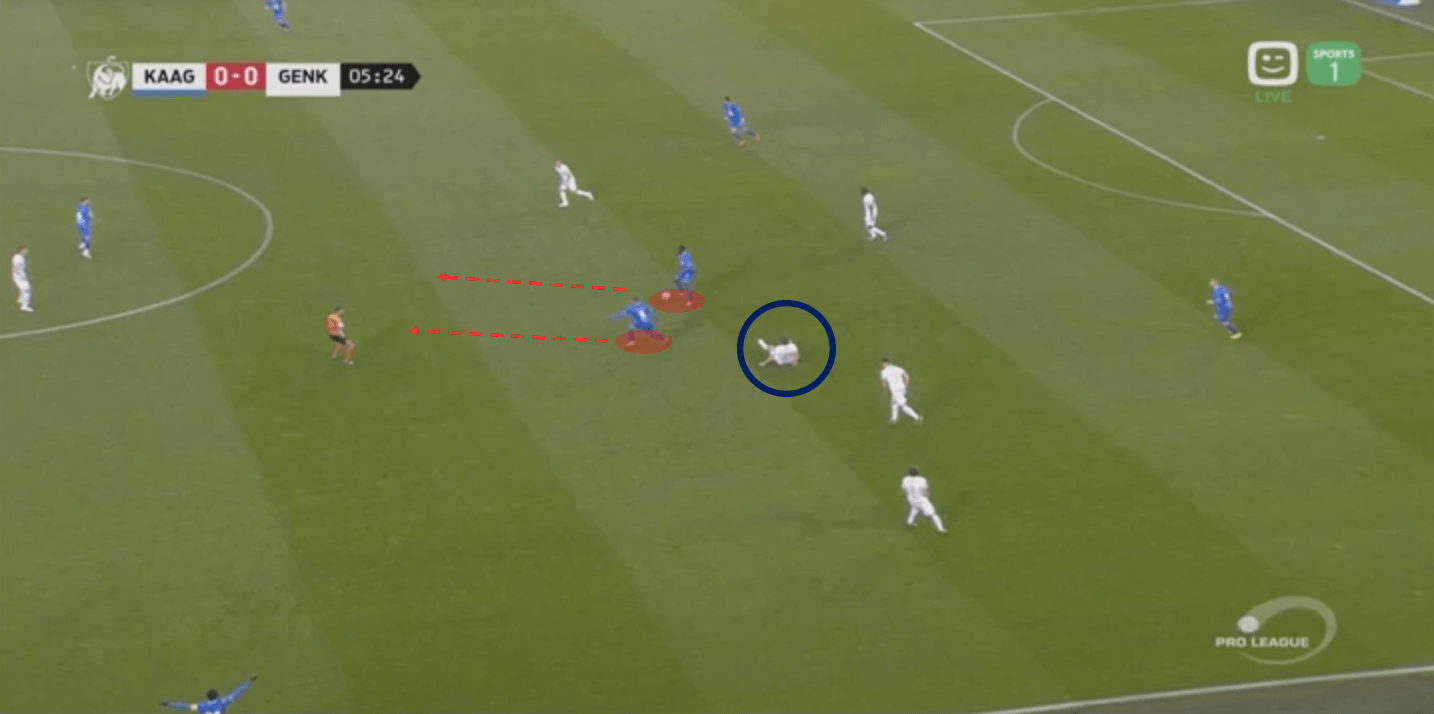
However, as Berge did in the previous example he over chases and unbalances himself. He is easily turned by his man and is left on the floor whilst Gent look to break away from him.
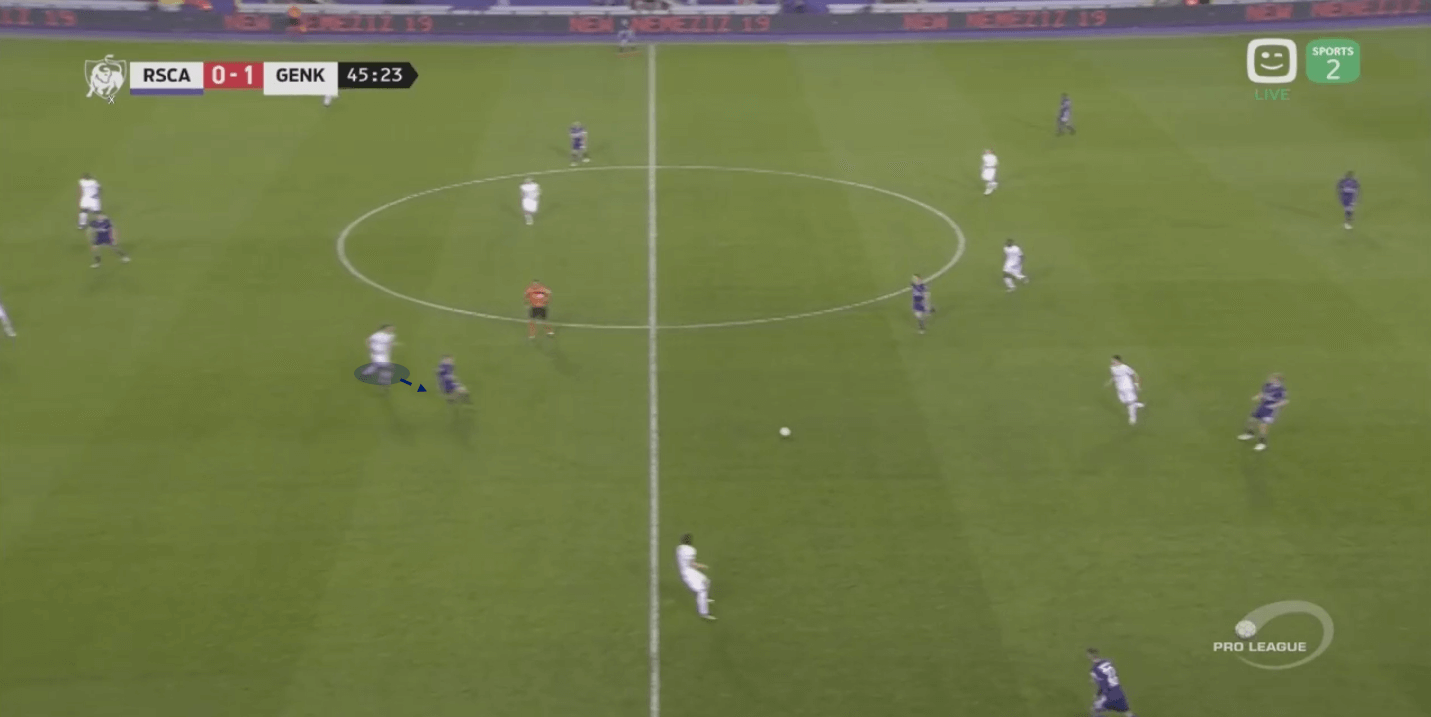
In a very similar example (above), Berge again moves towards an opposition player to apply pressure as he receives the ball. However, he again over chases and unbalances himself.
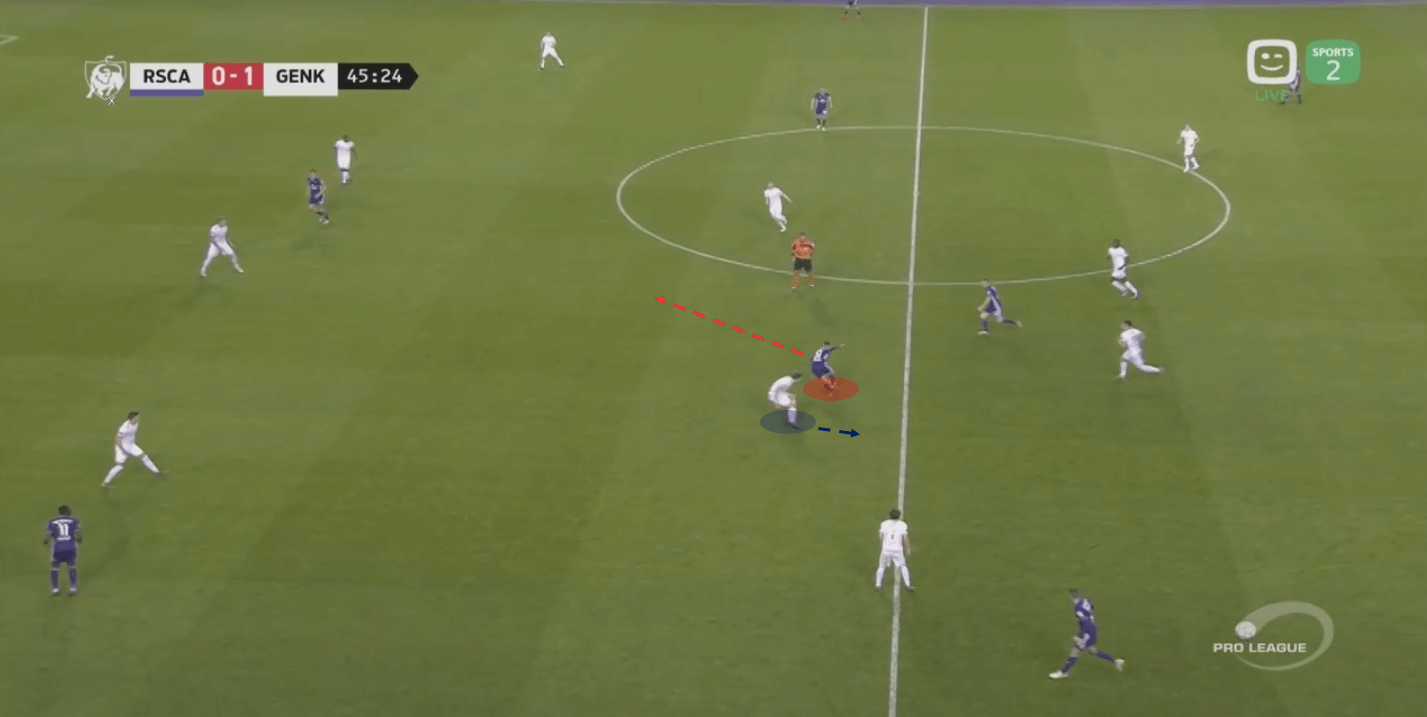
Berge is unable to shift his momentum or running direction and is easily turned by the Anderlecht midfielder. His decision to press so aggressively in a relatively unthreatening position leaves his back four exposed as well as the centre of midfield unmanned.
Berge on the ball
Sander Berge has proved that he is a competent defender, despite having some flaws to his game. But as mentioned in the opening of this article, a modern defensive midfielder must be capable on the ball as well as off it. A look at Berge’s stats somewhat suggests that he doesn’t contribute all that much to Genk’s attacking play with his passing. Berge makes 8.11 progressive passes per 90, 1.16 smart passes per 90 and 0.66 deep completions per 90.
When compared to other players in his position in the Belgian Pro League with a minimum of 900 minutes he ranks 27th, 31st and 44th in these stats respectively. This would suggest that these kinds of passes aren’t Berge’s forté or perhaps he isn’t required to play these passes in Genk’s system. He has an overall pass accuracy of 91.3% which shows that he is very tidy with the ball but perhaps doesn’t take too many risks with it. However, upon viewing footage of Berge there are some signs that there is an impressive passing ability somewhere in his locker.
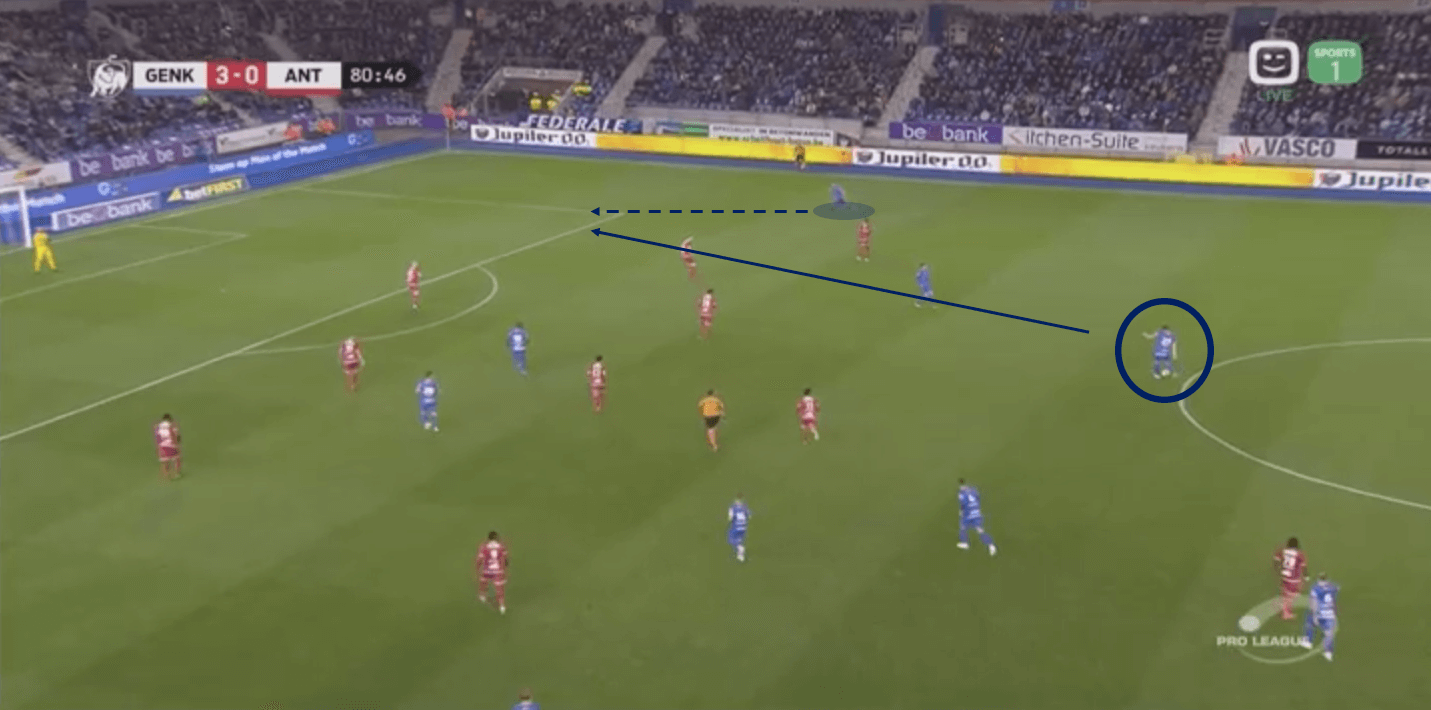
He has the ability to play the ball in the air and into space for attackers to run onto such as in the above and below examples.
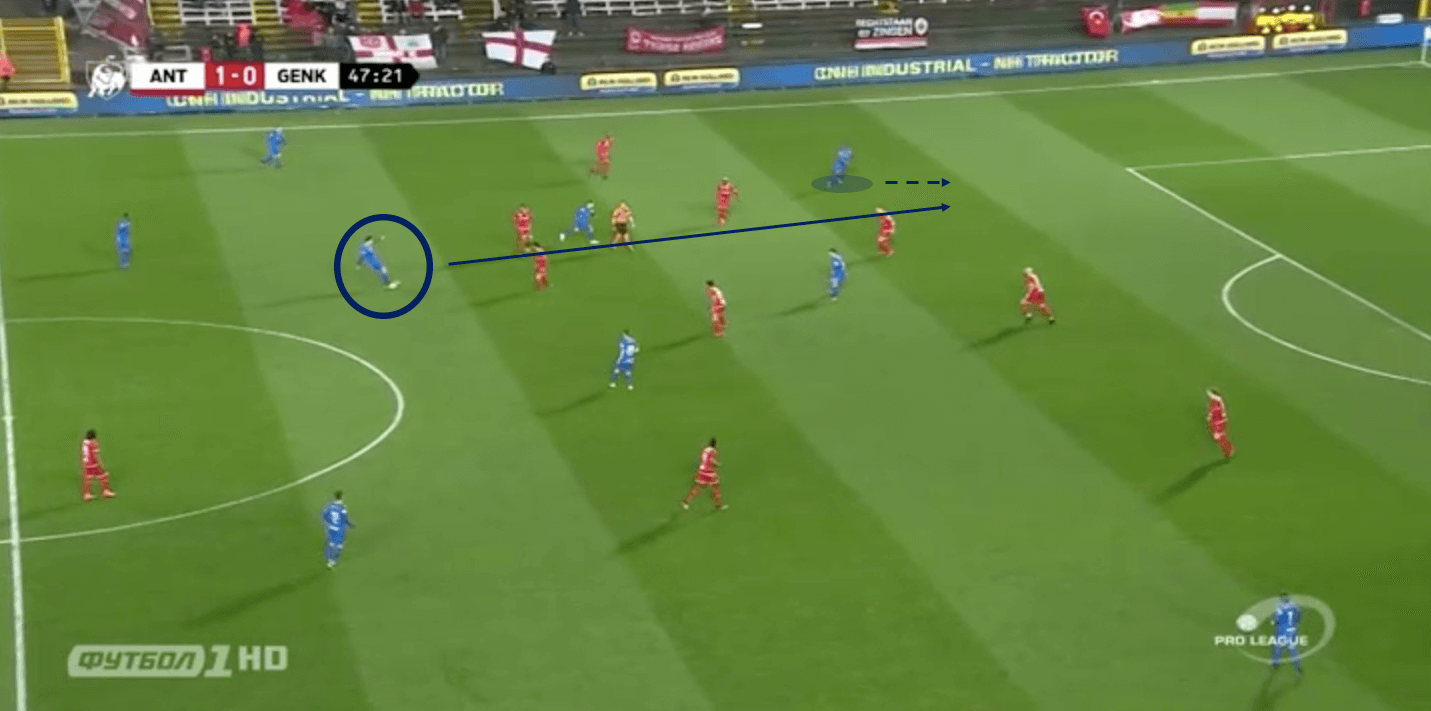
He has also shown he is highly proficient at finding eye of the needle balls into the final third such as in the examples below.
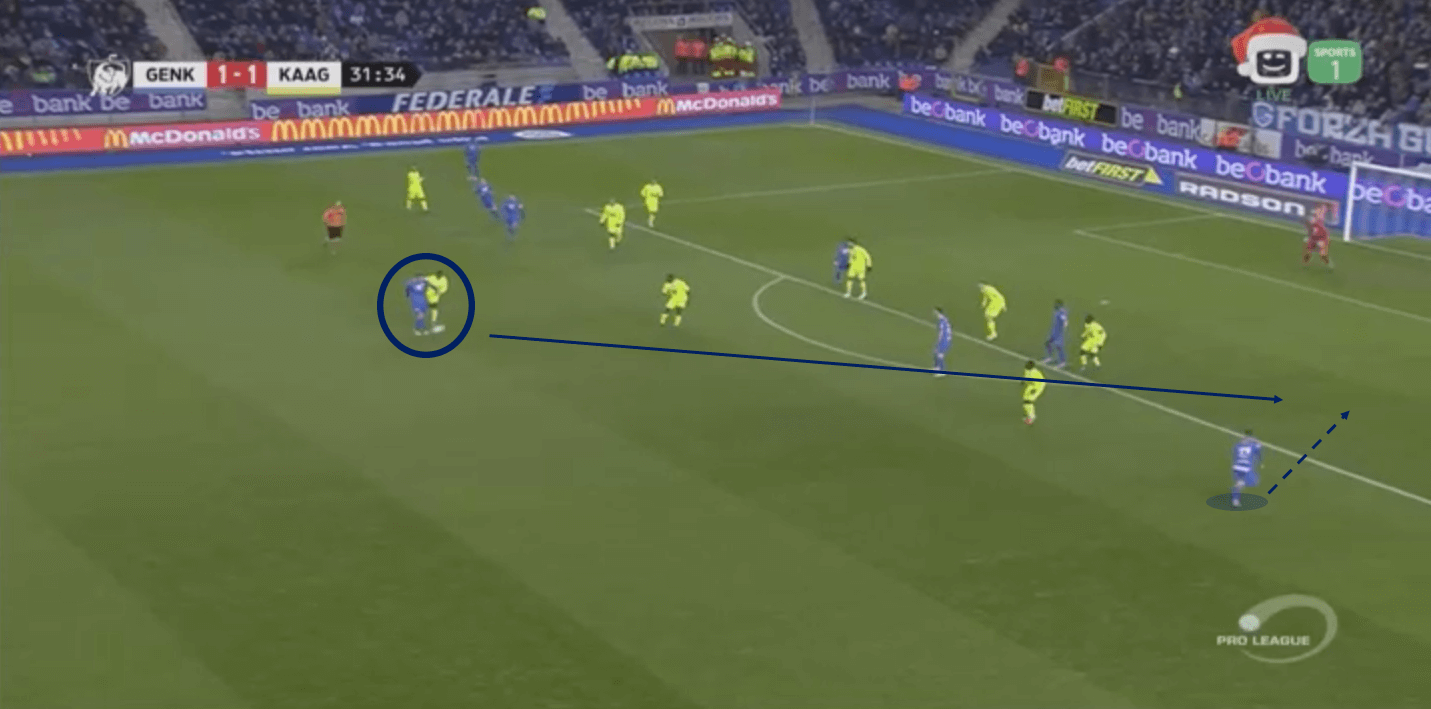
Berge makes 8.47 passes into the final third per 90 which ranks him as 22nd amongst players in the same position in the Belgian Pro League. He is, however, the most accurate with his passes to the final third amongst players in the same position with an 87.6% success rate.
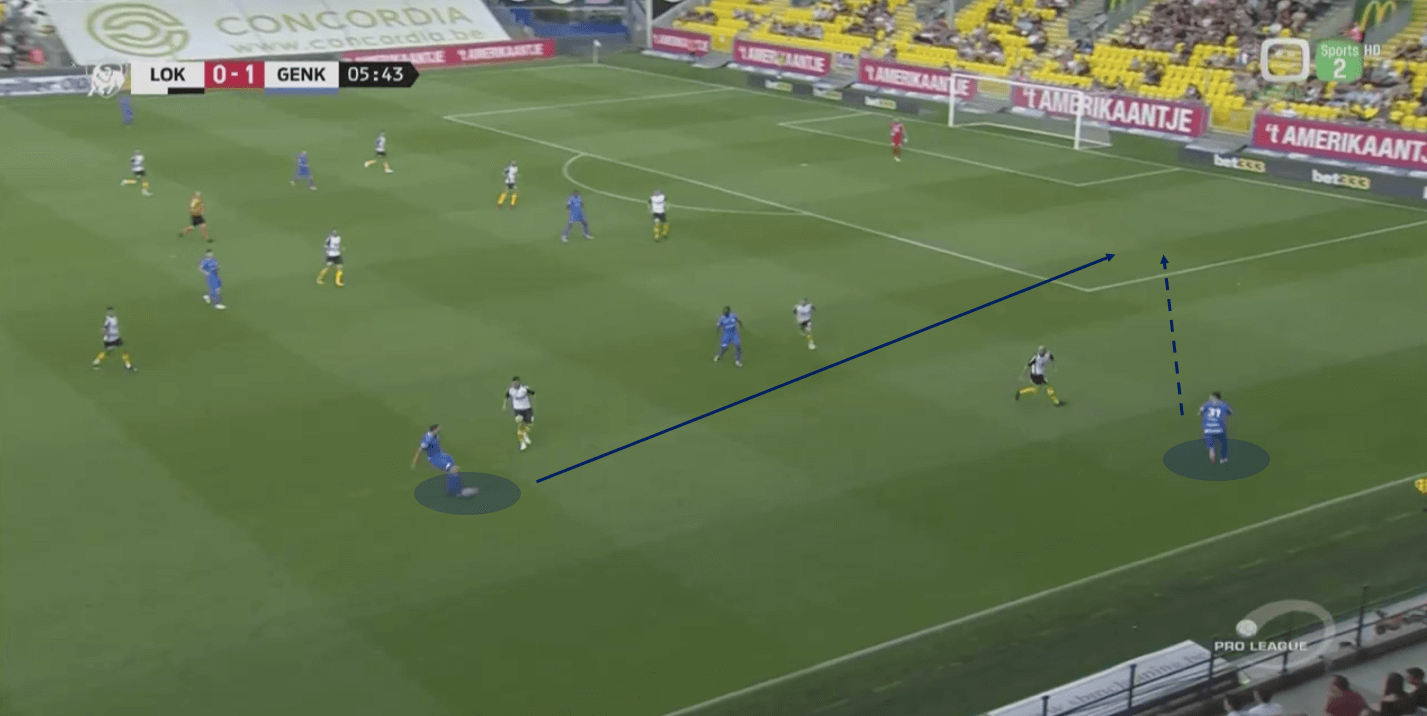
Despite having the obvious ability, it may be due to his role and responsibilities in the Genk side that he isn’t as involved in this area as one may think. However, something which makes Berge stand out amongst other players with similar profiles is his ability to beat a man which I will discuss in the next section.
Dembélé-esque dribbling
Upon watching Sander Berge the aspect of his game that stands out the most to me is his ability to beat his opposite man, create half a yard of space before holding them off and driving away from them and towards the final third in a Moussa Dembélé style. Berge makes 2.81 dribbles per 90 with an 87.7% success rate which ranks him 25th and 16th against players in a similar position to him in the Belgian league.
Whilst these rankings may not jump off the screen given Berge’s profile and build these are impressive numbers and provide a unique threat for Genk. Berge makes 2.3 progressive runs per 90 which is the 14th most of his midfield counterparts. When compared to his ranking in terms of smart/progressive passes and deep completions this highlights where and how Berge contributes to Genk’s attack.
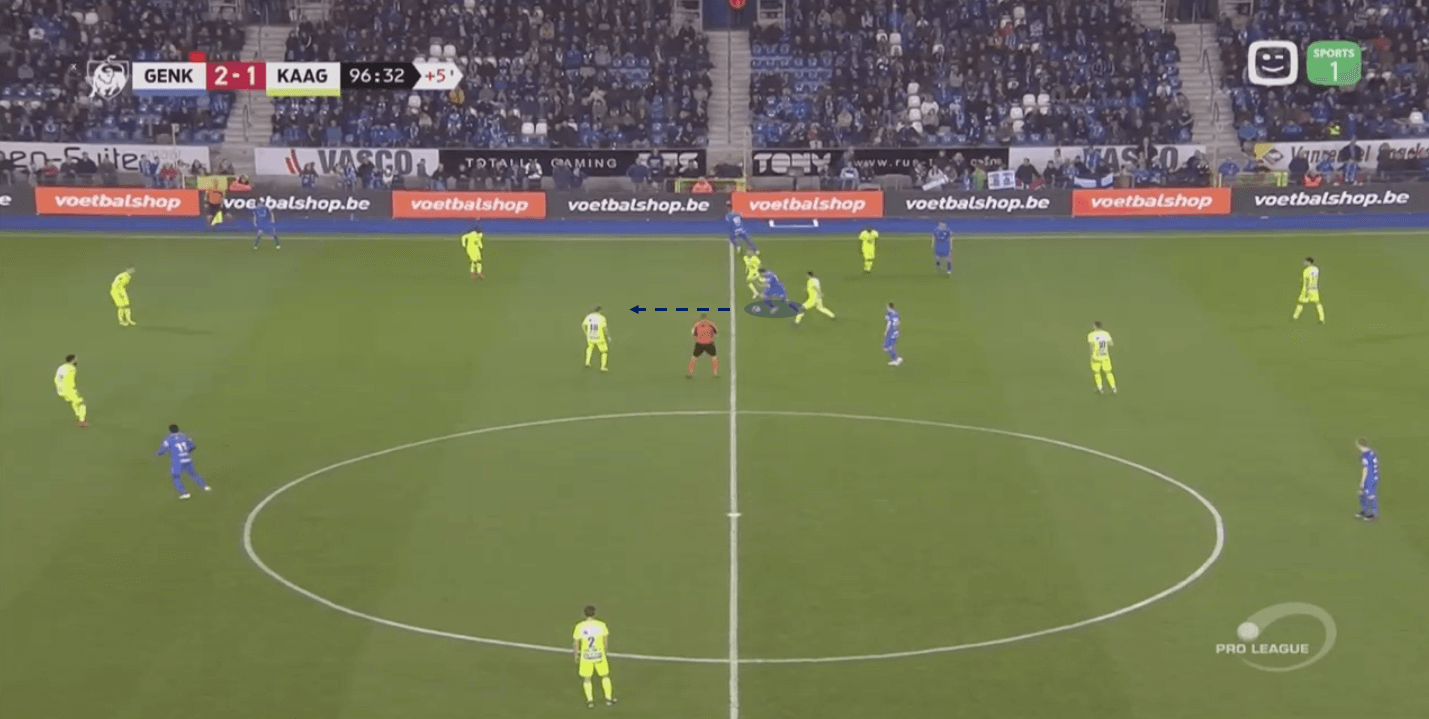
The image above is a small snapshot of Berge’s dribbling ability. He receives the ball from a ricochet with two Gent players around him. He knocks the ball half a yard in front of himself, holds off both men and moves into the Gent half with the ball.
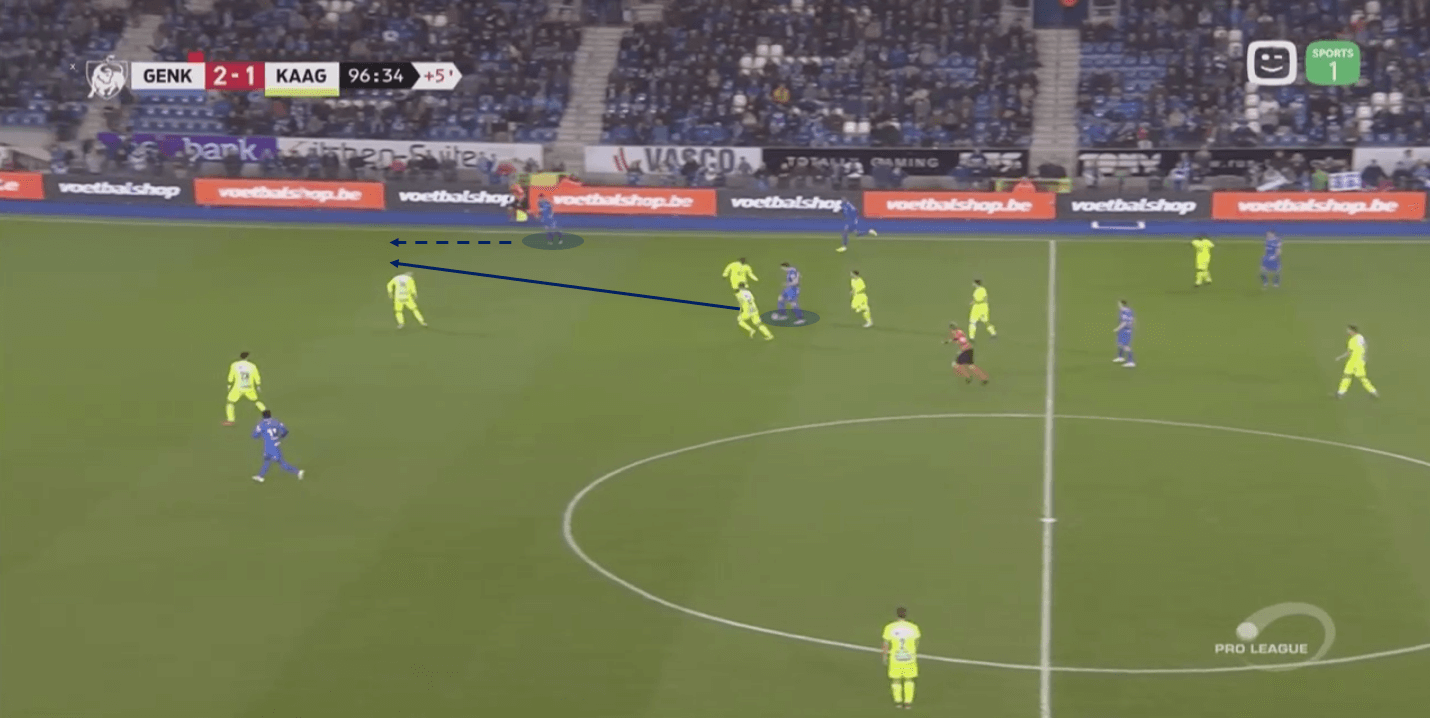
Upon creating half a yard for himself, he releases Genk’s right-midfielder down the line.
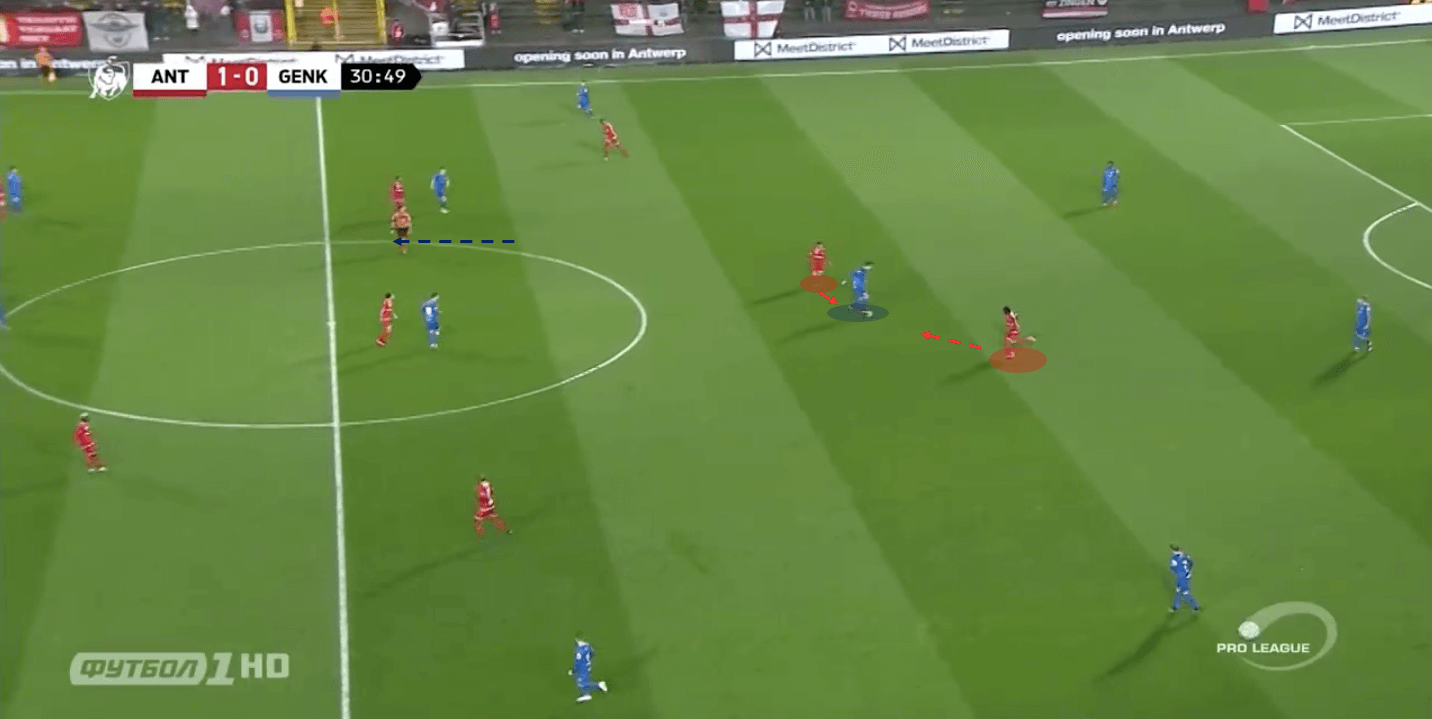
In the image above Berge again receives the ball with two defenders closing in.
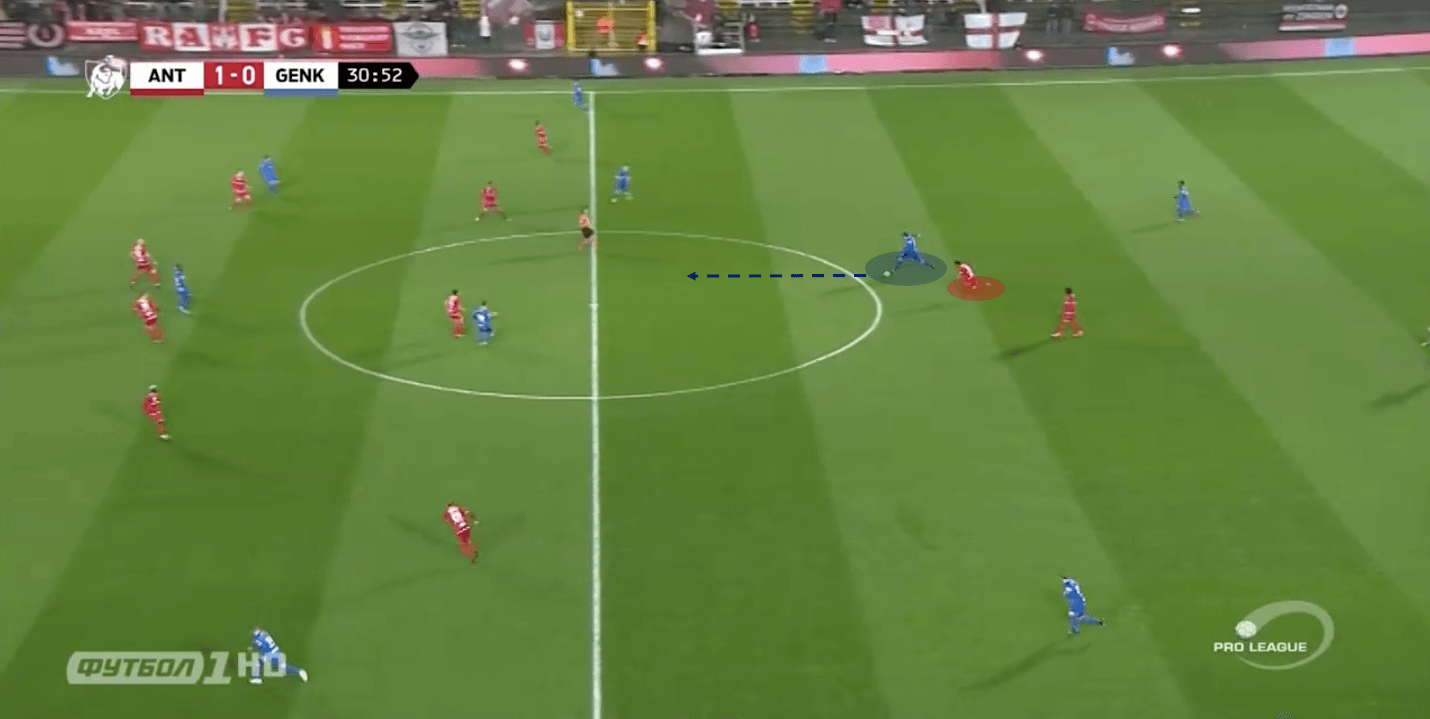
Berge holds off the closest man before using his body to turn and spin in behind him before driving into the heart of the midfield.
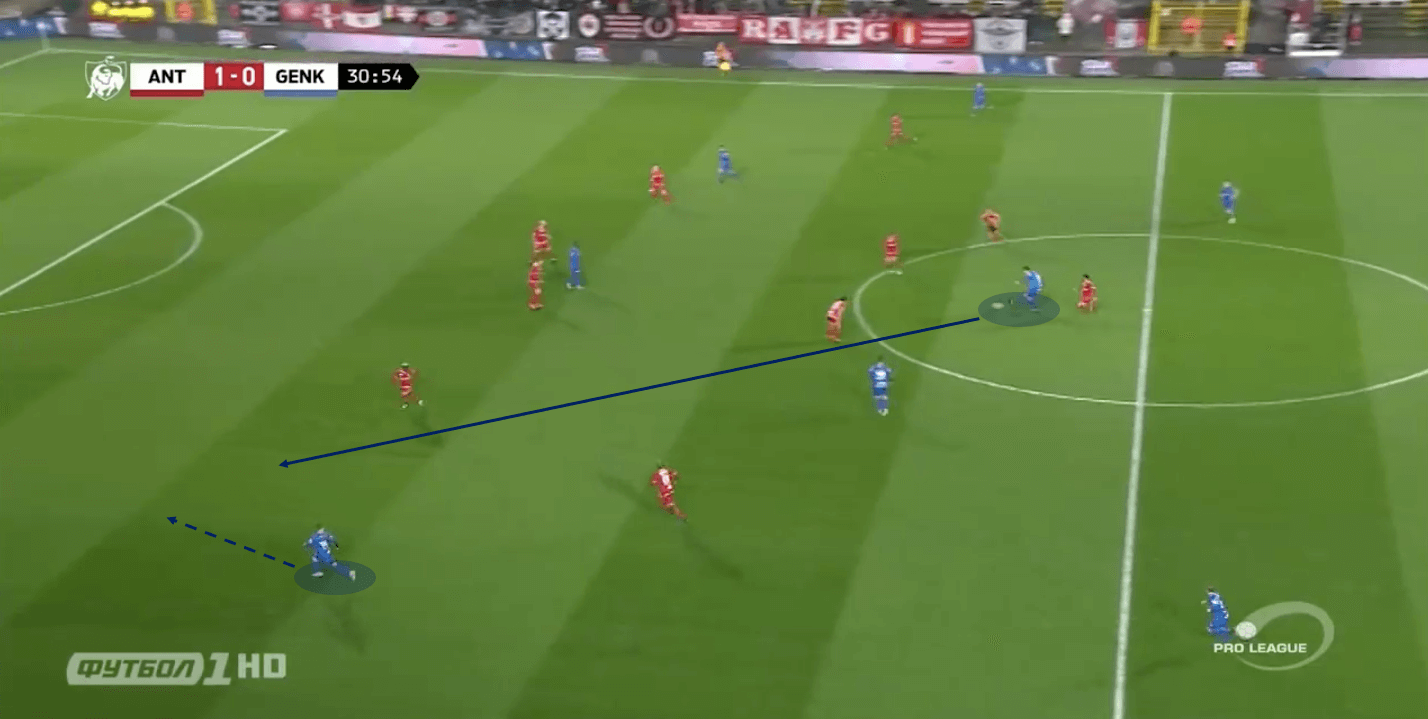
As in the example above, Berge chooses the perfect moment to release the ball to a teammate once he feels his dribble is completed.
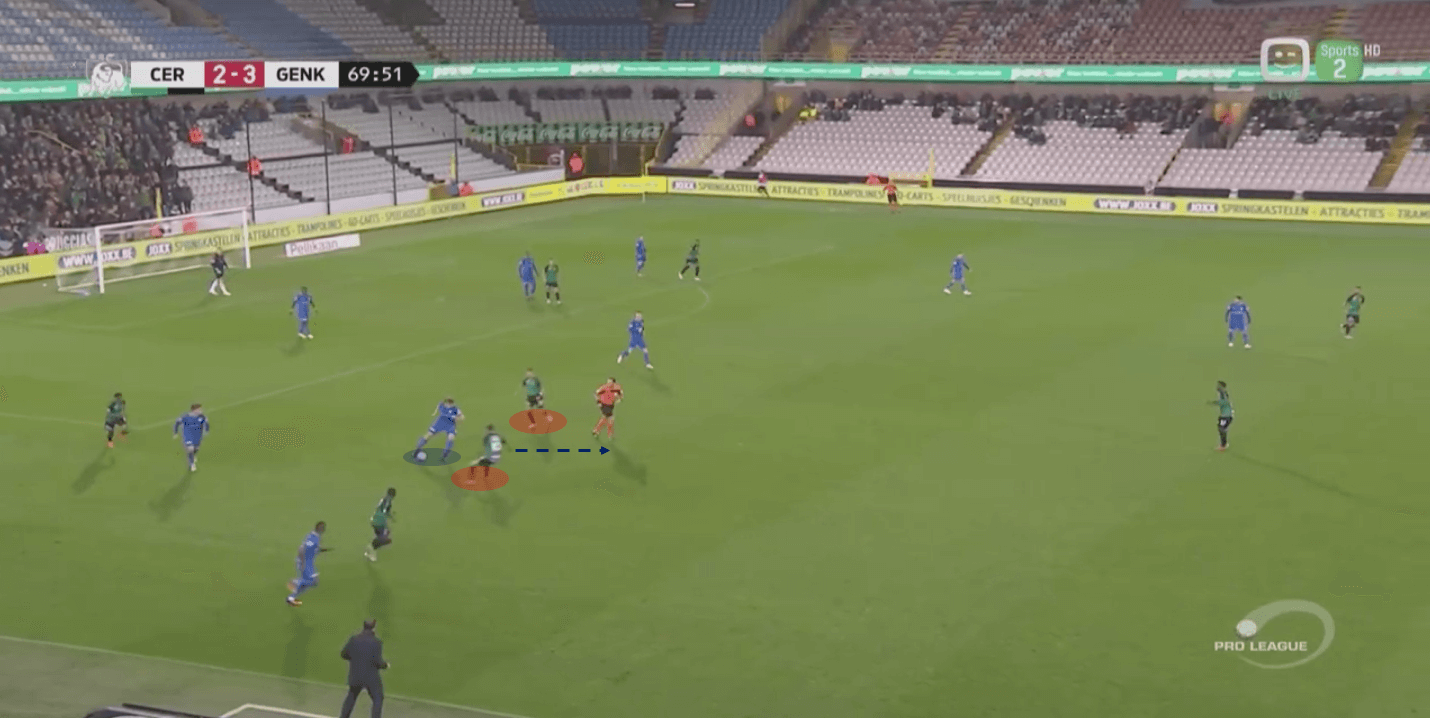
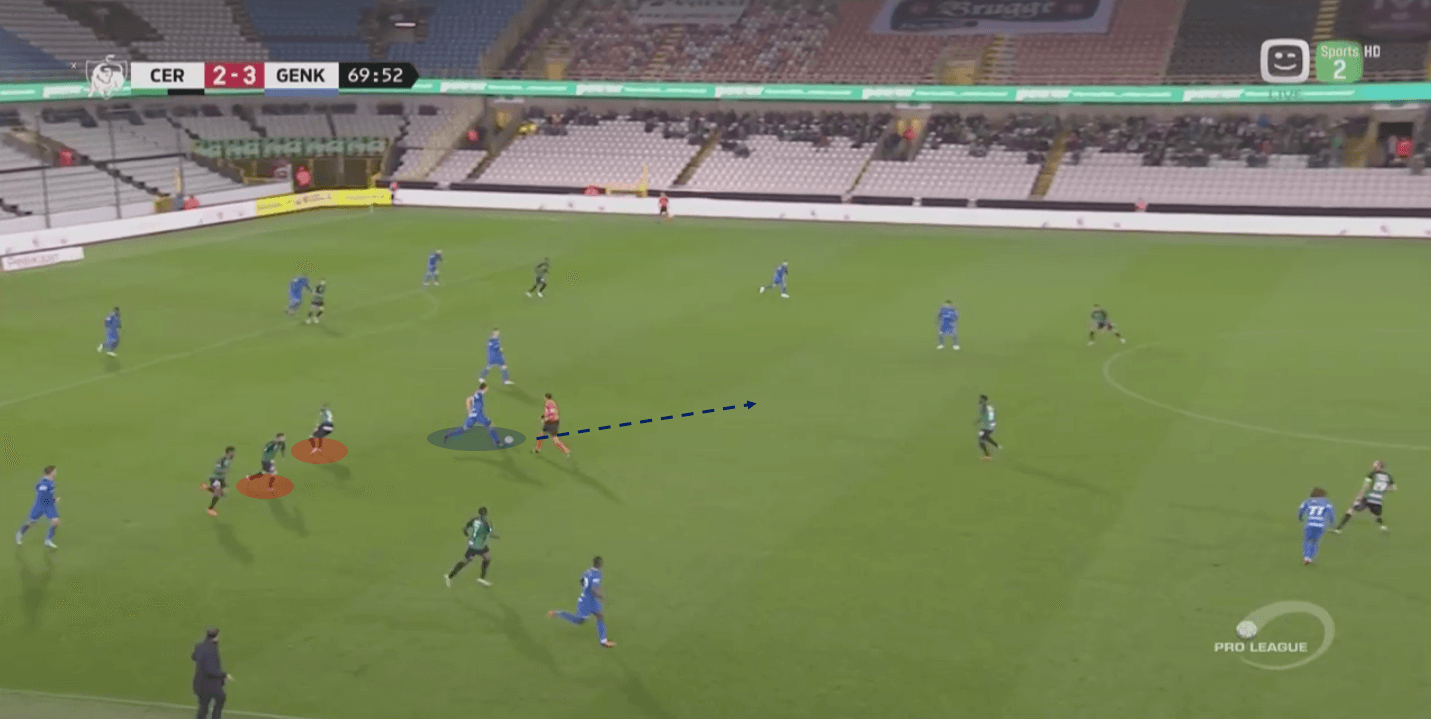
In the example above, Berge further exemplifies his press-resistance by leaving two defenders for dead by dribbling past both of them around 25 yards from his own goal.
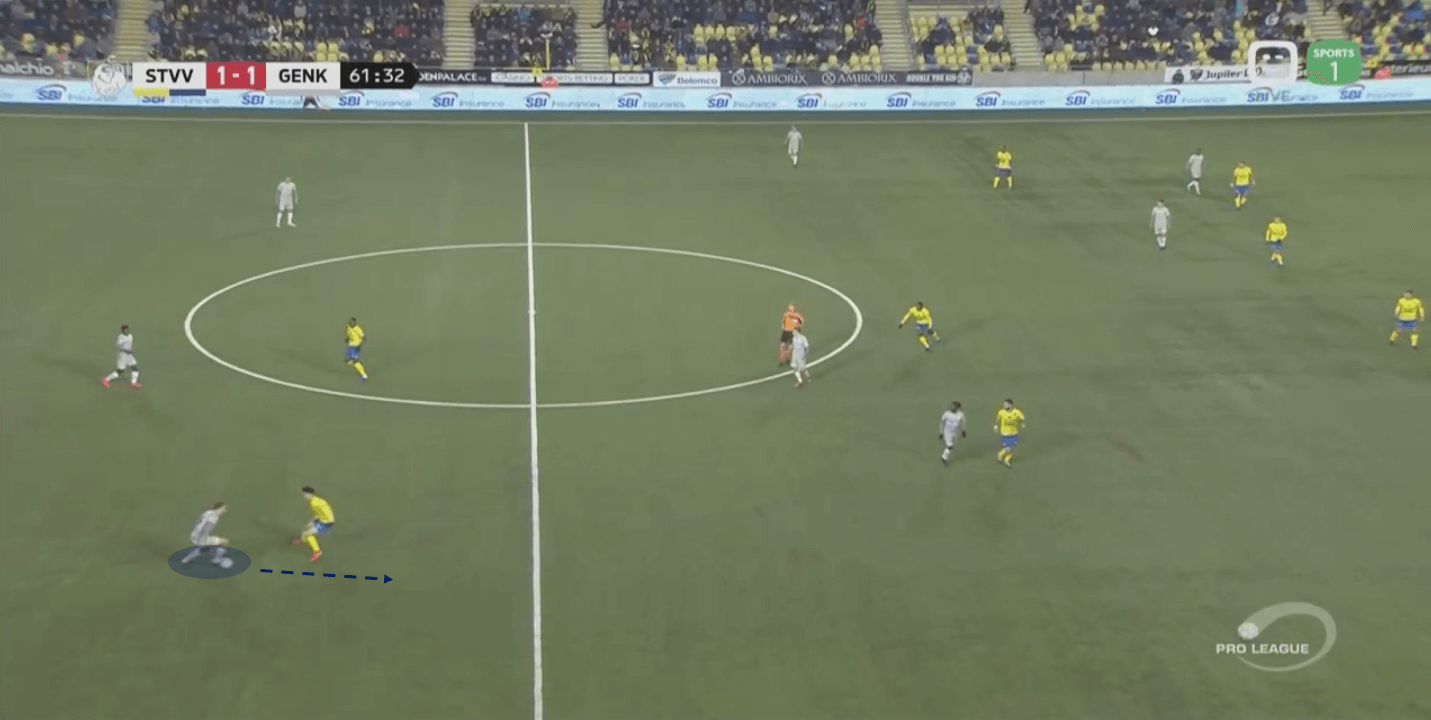
The following example encapsulates both Berge’s dribbling ability and his attacking decision making. He picks up the ball in the right-back position with an opposition player in close proximity. He shifts the ball past him leaving him for death before striding towards Sint-Truidense’s goal.
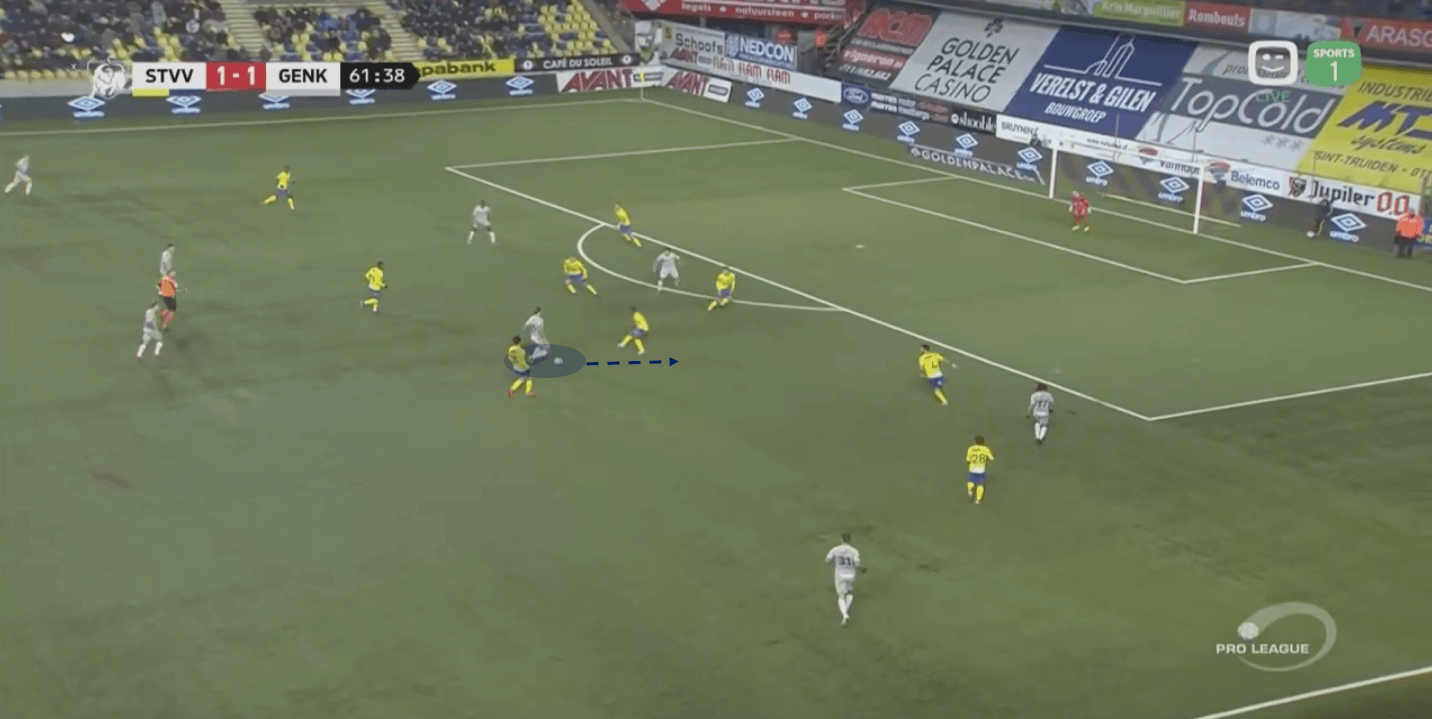
Berge is met around 10 yards from the Sint-Truidense penalty area. However, as with the first defender who challenged him, Berge easily moves past him.
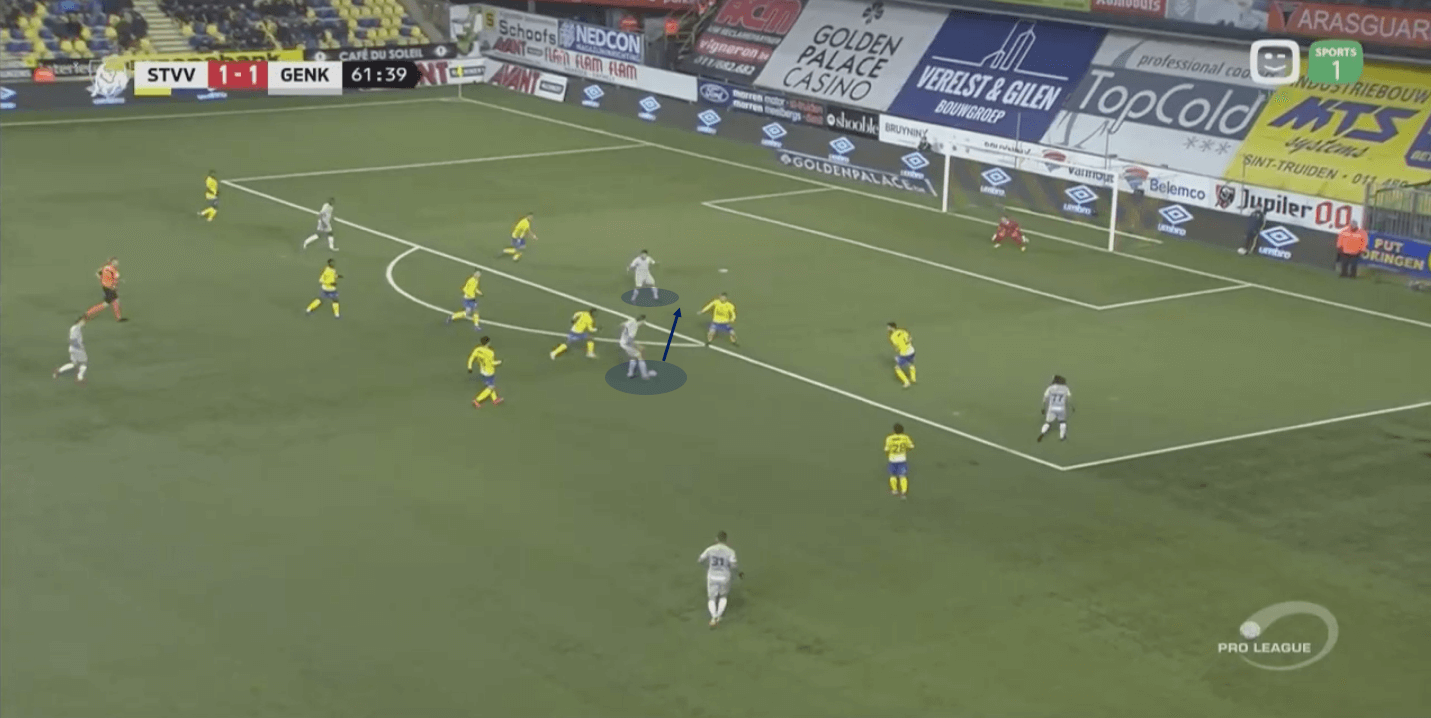
One of the Sint-Truidense central defenders is forced to move up to challenge Berge on the edge of the box, leaving the Genk centre-forward free in the middle of the box. Berge keeps his cool and picks out his teammate rather than seeing his name in the headlights and striking at goal. He carried the ball from his own half up to the edge of the opposition penalty area and still had the composure to pick out a teammate in a better goalscoring position than him.
Final thoughts
Sander Berge is certainly an interesting player. He is a good reader of the game, as evidenced with his passing ability but also his eye for danger when defending. At 21-years-old this is a very desirable skill to have. He does, however, need some improvement in a few areas of his game. His 1v1 defending is limited at times. This could be down to his lack of agility and balance which can often be exploited. A club looking to sign Berge may also look for greater output in terms of his passing. It is unclear whether his low numbers in deep completions, smart passes and progressive passes are due to Genk’s system and his responsibilities in this system or whether there is a limitation there.
His style of play is somewhat a mixture of Moussa Dembélé in terms of his dribbling and Nemanja Matić in terms of his 1v1 limitations. At this current moment, it seems unlikely that Berge could operate as a top-level defensive midfielder in a single pivot system given his lack of agility, such as the one played by Manchester City. However, alongside a midfield partner who can act as ballast for him, Sander Berge could thrive. I would certainly recommend him as a left-field choice for Tottenham’s midfield as he already appears to be a better option than Eric Dier or Victor Wanyama. Transfermarkt.com have Berge valued at around £19 million, so if the likes of Ndombele or Lo Celso are snapped up from under Tottenham’s nose or the asking price is too high, Berge could be a comparative bargain of a signing
If you love tactical analysis, then you’ll love the digital magazines from totalfootballanalysis.com – a guaranteed 100+ pages of pure tactical analysis covering topics from the Premier League, Serie A, La Liga, Bundesliga and many, many more. Buy your copy of the May issue for just ₤4.99 here, or even better sign up for a ₤50 annual membership (12 monthly issues plus the annual review) right here.

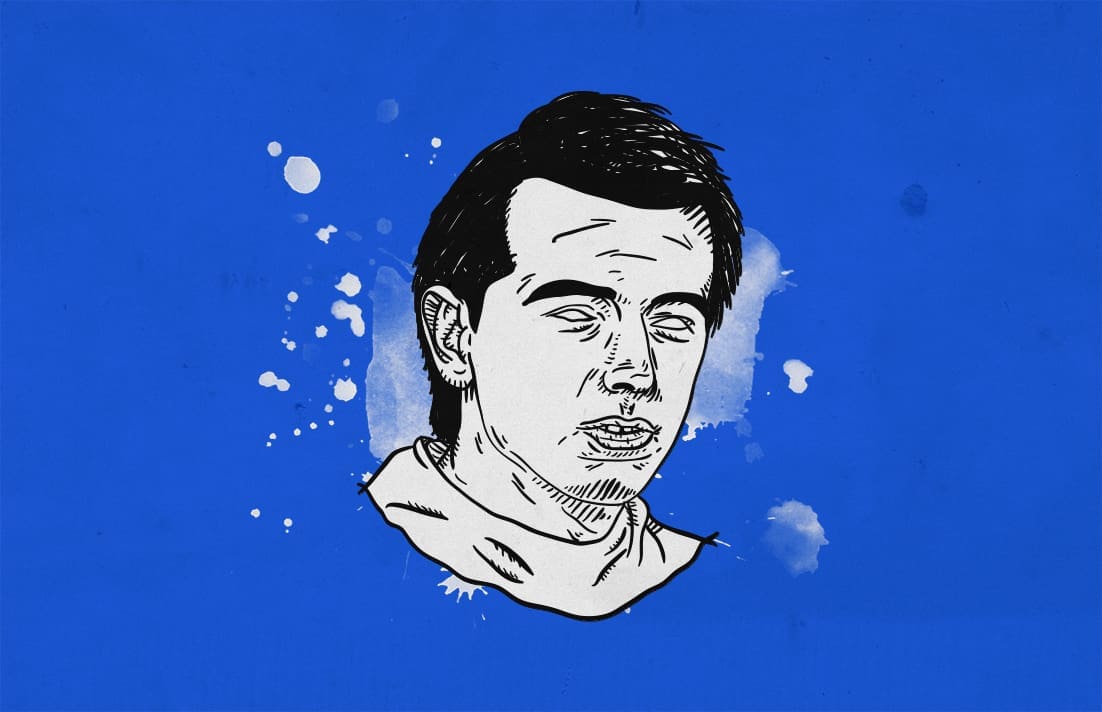



Comments